Local residents burn paper offerings as a ritual for deceased ancestors during the Zhongyuan Festival in Rongan, China. (STR/AFP via Getty Images)
Measuring Religion in China
Many Chinese adults practice religion or hold religious beliefs, but only 1 in 10 formally identify with a religion
August 30, 2023
From Pew Research Center
By virtue of its huge population, China is important to any effort to assess global religious trends. But determining how many people in China are religious today, and whether their religious identities, beliefs and practices have changed over the past decade, is difficult for many reasons. The challenges facing independent researchers include not just the Chinese government’s tight control of information and the Communist Party’s skepticism toward religion, but also linguistic and conceptual differences between religion in East Asia and other regions.
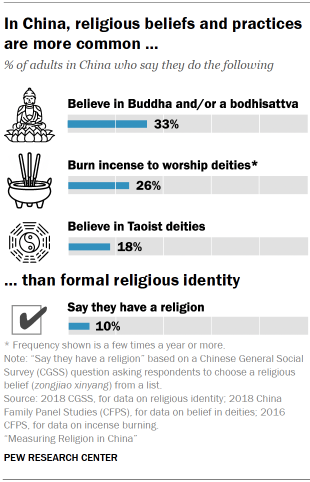
Because Pew Research Center has not conducted its own survey about religion in China, the Center’s demographers combed through data from various other sources – primarily surveys run by Chinese universities – to discern recent trends.
Depending on the source used, estimates of the share of Chinese people who can be described as religious in some way – because they identify with a religion, hold religious beliefs or engage in practices that have a spiritual or religious component – range from less than 10% to more than 50%.
For example, only 10% of Chinese adults identified with any religious group in the 2018 Chinese General Social Survey (CGSS).1 The Chinese language wording of this question – “What is your religious (zongjiao 宗教) belief (xinyang 信仰)?” – is understood in China to measure formal commitment to an organized religion or value system. Similarly, just 13% of Chinese adults say religion (zongjiao) is “very important” or “rather important” in their lives, according to the 2018 World Values Survey. Although these measures have fluctuated over time, none have clearly risen over the last 10 to 15 years.
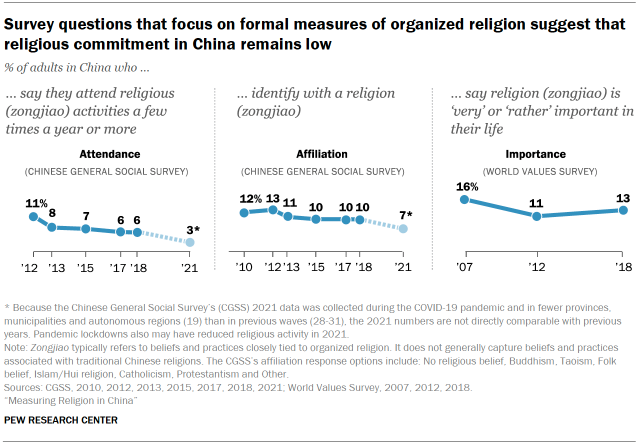
On the other hand, surveys indicate that religion plays a much bigger role in China when the definition is widened to include survey questions on spirituality, customs and superstitions.
For example, 33% of Chinese adults say they believe in Buddha and/or a bodhisattva, according to the 2018 China Family Panel Studies (CFPS) survey.2 The 2016 CFPS shows that 26% of Chinese adults burn incense at least a few times a year – a practice that, in China, typically involves making wishes to Buddha, a bodhisattva or other deities and often indicates hope in divine intervention.3 However, just 4% of Chinese adults claim Buddhism as their religious belief (zongjiao xinyang), according to the 2018 CGSS.
What ‘religion’ means in China
The discrepancy is partly due to linguistics: The closest translation of the English word “religion” in Chinese is zongjiao, a term Chinese scholars adopted in the early 20th century when they were working with Western texts and needed to translate “religion.” To this day, zongjiao – like the terms shūkyō in Japanese and jonggyo in Korean – refers primarily to organized forms of religion, particularly those with professional clergy and institutional or governmental oversight. Zongjiao does not typically refer to diffuse religious beliefs and practices, which many Chinese people consider to be matters of custom (xisu 习俗) or superstition (mixin 迷信) instead. (For more explanation of Chinese terms used in this Overview, refer to the Key terms section.)
Moreover, many Chinese people’s understanding of zongjiao may be influenced by the government’s view that religion reflects a backward mindset incompatible with socialism. In state media, for example, the term zongjiao is used alongside superstition to indicate corruption and wavering loyalty to the Chinese Communist Party.
But there is another reason why it is hard to pin down the number of people in China who are religious. It is a conceptual problem: Western definitions of religion and measures of religious participation – such as attendance at congregational worship services – fit the monotheistic religions of Christianity, Islam and Judaism but are less suited to traditional beliefs and practices in East Asia.
In China, as well as in neighboring countries such as Japan and South Korea, there are many beliefs (such as in spirits) and practices (such as visiting shrines and making offerings to ancestors) that might be considered religious, broadly speaking. But there is little emphasis on membership in congregations or denominations, except among Christians and Muslims in these countries.
In East Asia, the boundaries between philosophical, cultural and religious traditions – such as Buddhism, Confucianism, Shintoism, Taoism and folk religions with local deities and regional festivals – are often unclear. People may practice elements of multiple traditions without knowing or caring about the boundaries between those traditions, and often without considering themselves to have any formal religion.4
Government restrictions on religion
Another challenge in measuring religion in China is that some affiliations, beliefs and practices are less officially acceptable than others – and thus, presumably, less comfortable for Chinese people to disclose in surveys.
Although the government formally recognizes five religions – Buddhism, Catholicism, Islam, Protestantism and Taoism – it closely monitors their houses of worship, clergy appointments and funding. Many activities that could help to maintain or expand these five zongjiao groups are banned, including proselytizing and organized religious education for children, such as Sunday schools or religious summer camps.
Enforcement has varied over time and by province, but since President Xi Jinping came to power in 2012, local officials have been less likely to overlook such activities. Religions that are not officially recognized, including those practiced mainly by ethnic minorities or foreigners, also are subject to a host of controls. Some groups, such as Falun Gong (法轮功), are completely banned.
(For more detail, read the section on how Chinese government policies toward religion have changed in recent decades.)
In addition, some zongjiao groups, particularly Muslims, face harsh treatment. The U.S. government estimates that Chinese authorities have detained more than 1 million Chinese Muslims, primarily Uyghurs, in “specially built internment camps.” The U.S. State Department has described abuses against Muslims in the Xinjiang Uyghur Autonomous Region as crimes against humanity and genocide. The United Nations Office of the High Commissioner for Human Rights has said the detention of predominantly Muslim groups and deprivation of their fundamental rights “may constitute international crimes, in particular crimes against humanity,” though the UN report avoids the controversial term “genocide.” For its part, the Chinese government has denied all allegations of genocide, torture, forced organ harvesting and sterilizations involving Muslims. Chinese authorities describe their treatment of Muslims as education and counter-terrorism efforts.
Christian groups also have accused China of religious persecution. For example, the government has arrested “underground” Catholic bishops and priests who are not affiliated with the official Chinese Catholic Patriotic Association, as well as Protestants who attend unauthorized places of worship also known as “house churches” (jiating jiaohui 家庭教会). Some Christians reportedly have been held in internment camps.
Because of these policies toward Muslims, Christians and other religious groups, China consistently ranks among the countries with the highest levels of government restrictions on religion, according to Pew Research Center’s annual reports on the topic.
For all the linguistic, cultural and political reasons described above, many Chinese people may be reluctant to associate themselves with religion (zongjiao) or to consider themselves to have a religious belief (zongjiao xinyang). Some zongjiao adherents may choose not to reveal this identity in surveys. (For more discussion of this issue, read “Can Chinese survey data be trusted?”)
Because of political sensitivity, studying religion in China also can be a minefield for scholars.
Challenges facing scholars of religion in China
Scholarly interest in the scientific study of religion in contemporary China seemed to be rising at the beginning of this century. In 2004, Purdue University sociologist Fenggang Yang organized the first annual Conference of the Social Scientific Study of Religion in China and a related training program. The conference was held each year until 2020. Hundreds of Chinese scholars attended for training on social scientific approaches to religion, opportunities to present research, and publishing advice. Training programs emerged in the United States for scholars from China and non-Chinese scholars studying religion in China, especially at the Center on Religion and Chinese Society at Purdue University, which later evolved into the Center on Religion and the Global East. New journals and edited volumes emerged to publish the results of this scholarly activity.
However, in recent years, studying modern religion in China has become more problematic. While some scholars continue to research the current state of religion in China, others have abandoned the field due to Chinese government policies that discourage the study of sensitive topics. Scholars who continue to focus on religion do so with increased caution about the scope of their research and how they present their findings. Such trepidation is not limited to scholars living in China, nor is it exclusive to those studying religion. A 2018 survey of more than 500 scholars outside mainland China who study Chinese society, conducted by political scientists at the University of Missouri and Princeton University, found that the Chinese government monitors research activity and sometimes retaliates against researchers.
About 9% of the survey’s respondents said they had been “invited to tea” to discuss their research with Chinese authorities. Access to archives was denied to roughly a quarter of those who asked for it. In addition, 5% reported difficulties getting travel visas, and about 2% were formally banned from visiting China. Scholars researching Xinjiang and Muslims were among those most likely to report visa complications and interviews with authorities.
In their analysis of this survey data, researchers Sheena Chestnut Greitens and Rory Truex conclude that the Chinese government creates ambiguity to intimidate scholars. Two-thirds of respondents said their research was sensitive, and some changed a project’s focus or abandoned a project altogether because of its sensitivity. However, most did not report any direct intervention from a government official. Respondents were slightly more likely to say that a government official had issued a warning to them through a colleague than to say an official had approached them directly.
Another factor limiting knowledge about the state of religion in China is restrictions on survey research and ambiguity about what may be permissible in surveys. In recent years, it has become increasingly difficult and, in some cases, impossible for foreign organizations to partner with Chinese institutions to conduct surveys in China. Furthermore, the staff of Chinese survey organizations may be uncertain which religion questions will elicit pushback from the government, and they may be highly cautious when considering whether to include religion measures in surveys of general attitudes and behaviors.
To our knowledge, the only surveys still collecting national data on religion in China are academic surveys, such as the Chinese General Social Survey and the China Family Panel Studies, which are supported directly or indirectly by Chinese government funding. For many years, Pew Research Center has been interested in collaborating on a survey of religion and spirituality in China. However, after investigating the possibility of doing so with various partners in China, we concluded that, given government restrictions, we could not carry out a survey dedicated to religion at this time.
Cultural traditions with spiritual underpinnings
In addition to the formal zongjiao measures and explicitly spiritual ones (belief in Buddha, burning incense) previously discussed, this report also analyzes several widely practiced rituals and customs that are considered cultural but may have religious or spiritual dimensions.
These traditions are observed by many Chinese people with and without a zongjiao affiliation. Chinese surveys have not asked respondents whether they perceive spiritual significance in these beliefs and practices, and the available data does not tie these activities to specific religions.
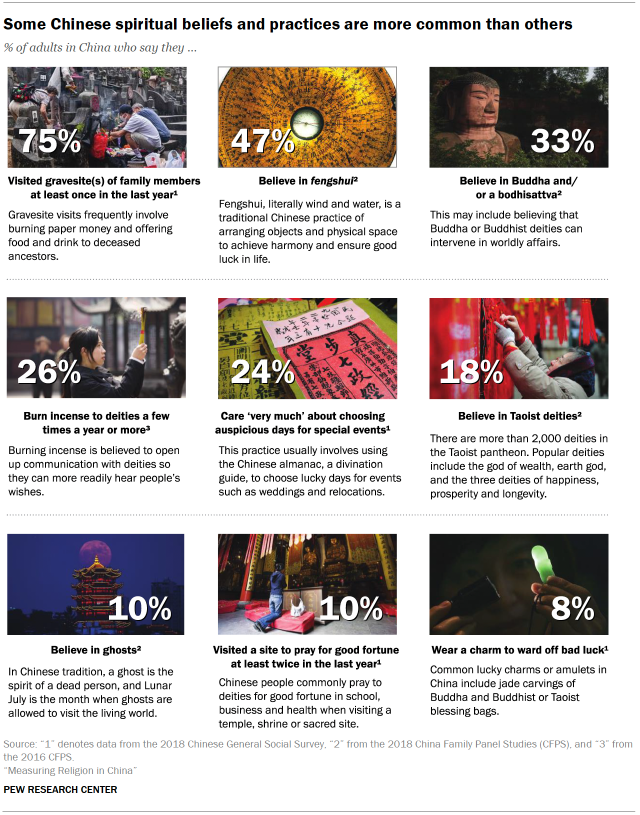
Gravesite visits
Three-quarters of Chinese adults visited a family member’s gravesite at least once in the last year, according to the 2018 CGSS. Visiting gravesites, especially on the Qingming Festival (Qingming Jie 清明节), or Tomb Sweeping Day, is part of the Confucian tradition of ancestor veneration (jizu 祭祖 or jisi zuxian 祭祀祖先). It commonly involves rituals with religious underpinnings, such as burning incense and “spirit money” or joss paper, making offerings of food and drink, and making wishes to ancestors.5
However, not all Chinese people engage in these rituals when visiting gravesites. For instance, some Chinese Christians may observe Tomb Sweeping Day to honor their parents or loved ones, yet intentionally distance themselves from ancestor worship by refraining from making wishes, burning “spirit money” or leaving offerings.
Fengshui
Nearly half of Chinese adults (47%) believe in fengshui (风水), according to the 2018 CFPS. Fengshui is a traditional Chinese practice of arranging objects and physical space to promote harmony between humans and the environment. Although people who practice fengshui may not think of it as a religious concept, it has roots in Taoism and sometimes involves belief in divine intervention.
Related practices include selecting auspicious days for important occasions and consulting fengshui masters to ward off bad luck.
Auspicious days
Six-in-ten Chinese adults (62%) say they care either “somewhat” or “very much” whether special occasions take place on an auspicious day or an inauspicious day, according to the 2018 CGSS. Choosing an auspicious day usually involves consulting the Chinese almanac or a fengshui expert. About a quarter of adults (24%) say they care very much about selecting auspicious days for special occasions, which can include weddings, funerals or moving to a new home.
Good fortune
Other traditional customs are less common. For instance, 24% of Chinese adults say they visited a site – typically a temple or shrine – to pray for wealth or good fortune in school, business or other matters in the past year, according to the 2018 CGSS. This includes 10% who did so twice or more in the past year. And 8% of Chinese adults say they carry a lucky charm or amulet to bring them good fortune or keep them safe from harm.
Mixing of beliefs
Many Chinese people engage in beliefs and rituals from multiple religious traditions. Chinese surveys do not ask respondents to state how often they do this, but a Pew Research Center analysis of data from the 2018 China Family Panel Studies (CFPS) indicates that combinations are quite common.
For example, about 40% of Chinese adults say they believe in at least one of the following: Buddha and/or a bodhisattva; Taoist deities; ghosts; and other gods or religious figures, such as Jesus Christ and Allah. And 20% believe in more than one of these religious concepts or deities. When fengshui (风水), a practice with Taoist underpinnings, is included, the share of Chinese adults who believe in both fengshui and at least one of these other ideas reaches 28%. The CFPS survey asks respondents whether they believe in each of the deities and religious concepts in a list. The Chinese term for “belief” (xiangxin 相信) used in this question does not necessarily connote religious faith. Refer to the Key terms section for more detail.
Some Chinese people who believe in figures associated with monotheistic religions, such as Allah and Jesus, also believe in traditional Chinese deities or supernatural forces. For example, about 7% of Chinese adults say they believe in Jesus Christ and/or Tianzhu (天主), a word used by Chinese Catholics for God. But only 2% hold such beliefs while rejecting all other deities and supernatural forces.
These are among the key findings of a Pew Research Center analysis of data on religion in China, part of the Pew-Templeton Global Religious Futures project, which seeks to understand global religious change and its impact on societies.
The remainder of this report includes:
- A chapter on signs of religious change in China
- Chapters on the major religious groups in China: Confucianism, Taoism and Chinese folk religions, Buddhism, Christianity, Islam, non-religion
- A brief history of Chinese government policy toward religion
1. Religious change in China
It is unclear whether there has been any significant change since 2010 in the percentage of Chinese adults who identify with a religion or engage in religious beliefs or practices.
Some scholars have relied on a mix of fieldwork studies, claims by religious organizations, journalists’ observations and government statistics to suggest that China is experiencing a surge of religion and is perhaps even on a path to having a Christian majority by 2050.
However, more than a decade’s worth of data from the Chinese General Social Survey (CGSS), the World Values Survey (WVS) and other large-scale surveys provides no clear confirmation of rising levels of religious identity in China, at least not as embodied by formal zongjiao (宗教) affiliation and worship attendance.
Changes in traditional beliefs and practices beyond zongjiao are difficult to quantify, due to a lack of comparable measures over time. Although several Chinese surveys have included questions about traditional beliefs and practices at least once, their wording and/or methodology have changed from wave to wave. As a result, these surveys cannot reliably measure change over time in traditional beliefs and practices.
In short, this report finds no empirical survey evidence that China has experienced a surge in religion since 2010 – but also cannot firmly rule it out, given the many sources of uncertainty.
Zongjiao measures
Overall, survey measures on zongjiao identity and practice, which capture a narrow and relatively formal range of religious engagement, have generally been stable since 2010, and in some cases seem to have decreased. According to the CGSS, 12% of Chinese adults claimed a religious affiliation (zongjiao xinyang 宗教信仰) in 2010. While this may seem slightly higher than the 10% who claimed a religious affiliation in 2018, the difference is within the margin of sampling error and is not statistically significant.
More recently, the 2021 CGSS found 7% of respondents identified with any religion. However, the 2021 wave covered fewer provinces and therefore may not be directly comparable with earlier waves.6
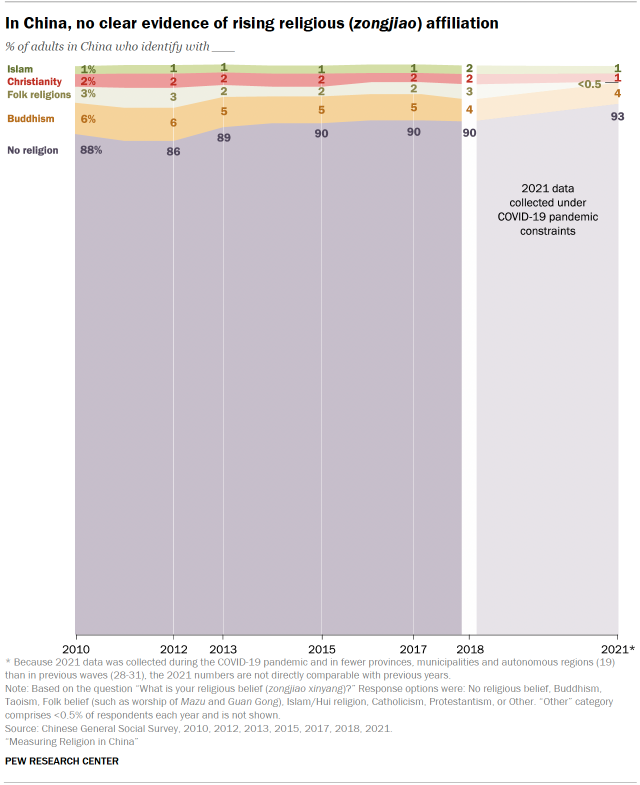
The CGSS does not show a significant increase in the shares of self-identified Catholics, Muslims, Protestants or Taoists during this period, and it indicates that the share of Chinese adults who formally identify with Buddhism dropped slightly.7
Meanwhile, fewer Chinese adults reported attending religious (zongjiao) activities. In 2012, 11% of respondents said they attended religious activities at least a few times a year. By 2018, 6% said they did so, a decline that is statistically significant. In the 2021 CGSS, just 3% of respondents reported attending zongjiao activities – though the 2021 figure may have been affected by a combination of COVID-19 pandemic restrictions and more sporadic sampling in China’s various regions.
What about the roughly one-in-ten respondents who claim a religious affiliation? Has their level of religious activity increased? The available data suggest the answer is “no.” The share of religiously affiliated Chinese adults who say they attend religious (zongjiao) activities at least a few times a year dropped from 53% in 2012 to 45% in 2018. In 2021, just 35% of religiously affiliated Chinese adults reported attending religious activities at least a few times a year – though, again, 2021 could be an anomalous year because of the pandemic.
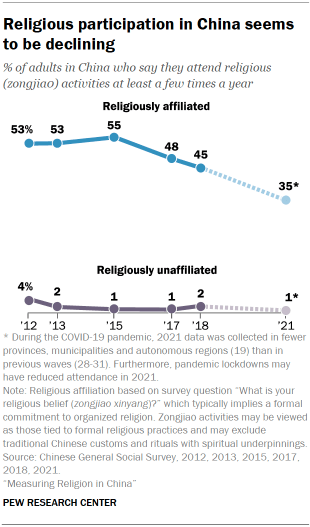
Between early 2020, when the coronavirus broke out in Wuhan, China, and the end of 2022, when the Chinese government reopened the country, all places of worship in China experienced temporary or long-term shutdowns as part of the central government’s “zero-COVID” policy.
Initially, in early 2020, all religious sites in China were closed, and gatherings were banned in an effort to contain the virus. Later that year, many sites reopened after the outbreaks in their local areas had subsided, but some sites remained closed. And some that reopened were subsequently shut down again due to fresh outbreaks or rebounding cases of COVID-19.
During the pandemic, some Chinese people engaged remotely in religious activities, such as virtually venerating ancestors on Tomb Sweeping Day (also known as the Qingming Festival) and attending Taoist services online. But it is unclear how virtual participation in zongjiao activities may have affected the way respondents answered the zongjiao attendance question in the 2021 CGSS.
Differences by age
An analysis of age patterns in the 2018 CGSS paints a mixed picture. For example, young adults are slightly less likely than older Chinese people to say they attend zongjiao activities. About 5% of Chinese adults under 35 in 2018 said they attend zongjiao activities a few times a year or more, compared with 8% of those ages 55 and above.
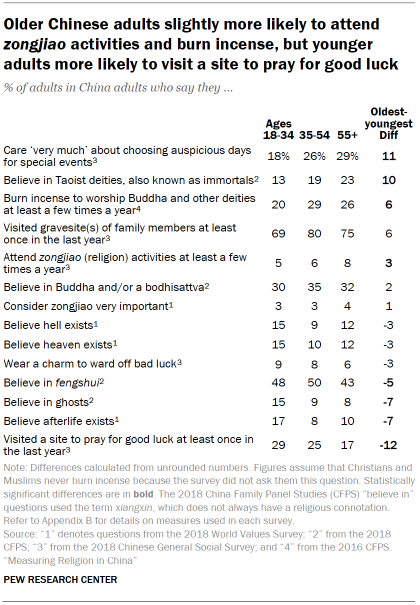
Surveys also indicate that younger adults are less likely than those ages 55 and older to care “very much” about choosing auspicious days for special occasions (18% vs. 29%), according to the 2018 CGSS. And younger adults are less likely to burn incense to worship Buddha and other deities, according to the 2016 China Family Panel Studies (CFPS) survey.
However, some folk religious beliefs and practices are more common among young Chinese adults than among their elders.
For example, 29% of adults under 35 reported in the 2018 CGSS that they had visited a place – typically a shrine or temple – to pray for good fortune in school, health or business in the past year, compared with 17% of those ages 55 and older. Adults under 35 also are somewhat more likely than older Chinese to believe in ghosts and in fengshui (风水), the 2018 CFPS finds.
There is no clear pattern by age group on several other measures, such as belief in Buddha and/or a bodhisattva or belief in heaven or hell.
(For more on how Chinese survey respondents may interpret these questions, read the discussion of Chinese religious traditions in Chapter 2.)
Official numbers of worship sites and personnel
Government figures on places of worship, as well as data on tourism at religious heritage sites, generally rose for traditional Chinese religions between 2009 and 2018. By contrast, the numbers of officially registered Protestant and Catholic churches and Islamic mosques remained virtually unchanged.
Meanwhile, the numbers of officially registered religious personnel have followed different trajectories, with some religious groups (such as Buddhist monks and nuns) experiencing increases and others (such as Taoist clergy) facing declines.
According to China’s State Council Information Office (SCIO), the total number of religious sites registered with the five official religious associations increased by 11%, from about 130,000 in 2009 to 144,000 in 2018, largely due to a surge in Buddhist and Taoist temples. The overall increase in worship sites outpaced Chinese population growth of around 6% during that time.
The SCIO does not track folk religion venues, as there is no supervisory religious association for folk belief. But data from several Chinese provinces that publish regional counts of folk religion temples indicates that these far outnumber the total number of registered worship sites.8 (For more about worship sites tied to traditional Chinese religions, read “How many Buddhist, Taoist, Confucian and folk religious sites are there in China?”)
While the SCIO’s count of religious venues is the most comprehensive dataset available, it has limitations: The figures do not include unregistered or unauthorized sites, and some authorized religious sites also appear to be missing. One possible explanation for this inconsistency is that the Chinese words for “register” – dengji (登记) or zhuce (注册) – are ambiguous. They can mean either “put on local government record” or “granted formal registration.” When local authorities report that they have “registered” a site, it is not always clear which of those two events has occurred.

Because local authorities across China have intensified their efforts since 2017 to absorb unauthorized places of worship into the official system (banning unauthorized churches that refuse to join the state-controlled associations), one might have expected to see an increase in the number of authorized Christian worship sites in recent years.9
However, government figures show no growth in the numbers of formally registered Protestant and Catholic sites between 2009 and 2018, the latest year for which official figures are available.
The next section presents government data on Taoist and Buddhist religious sites and personnel. Parallel discussions for other religions can be found in the Christianity chapter and the folk religion section.
Taoist and Buddhist worship sites and clergy
The number of officially registered Taoist temples tripled from 3,000 in 2009 to 9,000 in 2018, according to the SCIO.10 The number of officially registered Buddhist temples rose by about 68% during that time, from 20,000 to 33,500.
There is some evidence that most or all of this growth took place in the early part of that period.11 In 2012, the director of the National Religious Affairs Administration (formerly the State Administration for Religious Affairs), Wang Zuoan, shared numbers of Buddhist and Taoist temples that were identical to those released by SCIO in 2018, and the same figures were published again by People’s Daily, the Chinese Communist Party’s official newspaper.12
The increase in the number of registered temples associated with traditional Chinese religions was due, at least in part, to preferential government treatment. In the early 2010s, state and local authorities – eager to boost their local economies and cultural pride by promoting religious tourism – often permitted and even encouraged the construction or renovation of Buddhist, Taoist and folk religion temples.
By 2012, religious venues – which are mostly Buddhist and Taoist – reportedly accounted for nearly half the country’s top-rated (or 5A-rated) tourist sites.13
However, the surge in temple construction and registrations did not last, as the government in 2012 started to crack down on developers who built temples or erected Buddha statues to earn profits from religious tourism. Following guidelines to combat what authorities described as “the commercialization of Buddhism and Taoism,” local authorities began tearing down large, outdoor Buddha statues in unauthorized temples and terminating the construction of unregistered temples. In 2017, the state intensified these efforts, banning any commercially oriented temple construction altogether.
In addition, the number of Taoist and Buddhist clergy did not keep pace with the increase in temples between 2009 and 2018. Taoist clergy dropped by about 20% during this time to 40,000, while Buddhist clergy rose by around 11% to 222,000, according to the SCIO. (Taoist clergy include Taoist priests as well as monks and nuns who have gone through the ritual of ordination; Buddhist clergy refer only to fully ordained monks and nuns.)
These different trajectories may have multiple causes, including that new temples meant to serve tourists may require fewer religious personnel. Meanwhile, as China’s economy has expanded and more people move to cities, monastic life seems to be gradually losing appeal. Even at-home Taoist priests (huoju daoshi 火居道士) may find it difficult to continue the tradition of passing down clergy positions from generation to generation.
In addition, the government’s ban on religious education for children and a law requiring all children to attend schools for a minimum of nine years have added extra challenges for religious groups that largely rely on monastic education to train monks and nuns.
Religious tourism

Government data indicates that tourist destinations featuring religion, such as Mount Jiuhua, a Buddhist sacred site, and Mount Wudang, a Taoist holy place with around 200 temples, experienced large increases in visitors between 2010 and 2019.
These gains correspond with an overall boom in domestic tourism in China. In the decade before the coronavirus outbreak, the annual number of domestic tourist visits nearly tripled, from 2.1 billion in 2010 to 6.0 billion in 2019, according to China’s Ministry of Culture and Tourism.
While visitors who travel to religious sites are not necessarily pilgrims, many engage in religious activities at temples and shrines, such as praying for good fortune.14 A study of tourists to Hanshan Temple found that fewer than one-in-six said they visited just for sightseeing, while about half said they had multiple reasons for the trip, including sightseeing, praying for good fortune and engaging with Buddhist history.
A different survey, conducted in 2014, found that about 17% of visitors to Mount Wudang described their trip as a pilgrimage, although fewer than 3% identified as Taoist.
2. Confucianism, Taoism and Chinese folk religions
People burn incense to the god of wealth at Guiyuan Temple in Wuhan, China, in 2017. (Visual China Group via Getty Images)
Confucianism
Named after the sage Confucius (b. 551 B.C.E.), Confucianism is one of the most important philosophical traditions in China. Although it’s widely considered a spiritual philosophy, some scholars classify it as a religion. Its beliefs center on a pervasive, invisible divine power – tian (天), usually translated as “heaven” – that controls humans’ fate and destiny. Confucian teachings focus on filial piety (xiao 孝), loyalty (zhong 忠) and benevolence (ren 仁).
Taoism (religious)
Founded by Zhang Daoling, religious Taoism (Daojiao 道教) dates to the second century C.E. The principal teachings of religious Taoism – similar to philosophical Taoism – focus on nonaction and harmony with the Tao, or universal order. Traditional practices include meditation; self-discipline in diet, exercise and sex; and rituals to promote harmony with the heavenly order or higher forces of the cosmos.
Chinese folk religions
Also called folk belief or minjian xinyang (民间信仰), Chinese folk religions were recorded as early as the Shang dynasty (c.1600-1046 B.C.E), well before Confucianism and Taoism. Folk religions originated in shamanism, and today include a broad range of beliefs and practices directed at supernatural forces — such as fortune telling and making wishes to ancestors and gods. Folk deities include the goddess of the sea (Mazu 妈祖) and the god of wealth (caishen 财神).
Relatively few Chinese adults formally identify with religious and philosophical traditions that originated in China – in large part because, unlike Abrahamic religions, these traditions do not emphasize membership. Moreover, Chinese people generally do not refer to these traditions as religion (zongjiao 宗教).
But Confucianism, Taoism and folk religions nevertheless have a role in the lives of many Chinese people. While a tiny share of Chinese adults describe themselves as believing in (xinyang 信仰) Taoism (Daojiao 道教), Confucianism (Rujiao 儒教 or Rujia sixiang 儒家思想) or folk religions (minjian xinyang 民间信仰), far more say they hold beliefs or engage in practices tied to these traditions.
And even though the Chinese government does not consider Confucianism to be a religion, some of its characteristics are within scholars’ conception of religion. For instance, the Confucian ritual of ancestor worship (jizu 祭祖) – an expression of filial piety (xiao 孝) toward deceased family members – often entails a belief in ancestral spirits and their supernatural power to intervene in earthly affairs.
Buddhism, which is considered a “traditional Chinese” religion even though it originated in India, has strong links to these other belief systems. (Read Chapter 3 on Buddhism.)
Confucianism, Taoism, folk religions and Buddhism are often deeply intertwined, and the differences among them can be indistinguishable to Chinese people. For example, Confucian teachings on ancestor veneration permeate China’s spiritual traditions, such as in the Buddhist Ullambana Festival (Yulanpen Jie 盂兰盆节) and Taoist Zhongyuan Festival (Zhongyuan Jie 中元节). Both events take place annually in Lunar July, a time when ghosts, including deceased ancestors, are believed to visit the world of the living. And both festivals incorporate filial piety (xiao), as manifested during a ritual in which ancestral spirits are commemorated and “rescued” from their suffering.
Folk beliefs and practices, meanwhile, incorporate Confucian, Buddhist and Taoist concepts and also turn them into distinctly folk religious elements. For instance, the popular folk deity, the goddess of mercy (Guanyin 观音), was originally the Buddhist figure Avalokiteśvara, a bodhisattva of compassion often depicted as genderless or male. In Chinese folk religion, Guanyin is understood as a goddess who answers all prayers, including requests for wealth, health, good fortune and giving birth to a son.
Historically, Confucianism, Taoism and folk religions – along with Buddhism – have helped shape Chinese people’s understanding of the universe. Even today, these traditions are tied to Chinese social norms and the country’s national holidays. Confucianism, Buddhism and Taoism, which in the past were frequently referred to as the “Three Teachings,” typically garner more support from educated elites and authorities than do folk religions, which historically have been marginalized as “illegitimate” and “unorthodox.”15
In 2015, the Chinese General Social Survey (CGSS) included a question about Confucianism and moral values: “Some people say the moral conditions in society are not ideal. If we were to restore moral values in society, what role do you think the Confucian tradition should play?” About two-thirds of respondents said efforts would need to rely at least partly on the Confucian tradition.
Authorities in China often differentiate between traditional beliefs and practices they consider to be “custom,” which are tolerated, versus those that are “superstition” and therefore discouraged or banned. (Some superstitious activities deemed to be “harmless” are allowed.) These distinctions may be blurry and subjective, but they are at least partly rooted in the history of Confucianism, Taoism and folk religion in China.
Festivals and traditions honoring ancestors
The Confucian practice of paying respects to deceased ancestors as if they were living is observed across religious traditions during the month of Lunar July, a time when tradition teaches that the gate of the underworld opens, and ghosts and spirits, including deceased ancestors, are allowed to visit the world of the living.
Folk religion: (Hungry) Ghost Festival (Gui Jie 鬼节)
People make offerings of food and “spirit money” to ghosts and ancestors.
Buddhism: Ullambana Festival (Yulanpen Jie 盂兰盆节)
A festival centered on filial piety and gratitude to all beings. Buddhist monks traditionally perform a ritual called “releasing the flaming mouth” to rescue ghosts, including ancestors, from their suffering.
Taoism: Zhongyuan Festival (Zhongyuan Jie 中元节)
The Taoist deity, Ruler of the Earth, is believed to pardon ghosts of their sins. Taoist priests perform Zhongyuan fasting and offering rituals to rescue ghosts, including ancestors, from their suffering.
Beliefs and practices
Beliefs and practices tied to Confucianism, Taoism and Chinese folk religions generally fall into three broad areas: filial piety (xiao 孝) and ancestor worship (jizu 祭祖), veneration of deities and ghosts, and beliefs that involve supernatural forces, such as fengshui (风水).22
While some of these concepts appear to be distinctly Confucian (ancestor worship), Taoist (belief in Taoist deities), folk religious (caring about auspicious days) or even Buddhist (belief in Buddha and/or a bodhisattva), they defy clear categorization. There is a lot of overlap among these traditions, and Confucianism, Taoism, folk religion (and Buddhism) all are considered to be part of traditional Chinese culture.
In addition, Chinese people often engage in religious beliefs and practices with a range of origins without distinction. Folk religion in particular blends elements from a variety of Chinese traditions, so separating folk beliefs and practices from more “orthodox” belief systems is particularly difficult.
Filial piety and ancestor worship
In its basic form, filial piety (xiao) refers to one’s duties and indebtedness to parents, even after their death. These duties include respect, obedience and care for parents and elderly family members.
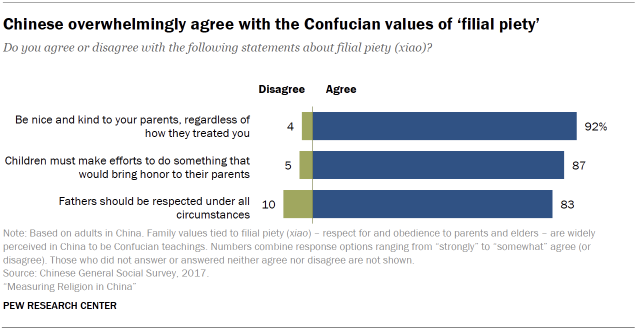
In Confucian teachings, ancestor veneration – and the associated ancestral rite (jili 祭礼) described in Confucian texts – is an expression of filial piety. Confucianism’s tenet of filial piety is a pillar of social norms across East Asia and parts of Southeast Asia.
As described in “The Analects,” the ancestor veneration ceremony or rite involves fasting in preparation, wearing ceremonial costumes, and offering elaborate meals to deceased ancestors. One is expected to perform the rites carefully and pay respects to the deceased as if they were living. Confucius was said to insist that venerating ancestors is not a religious act but a form of fulfilling filial responsibilities. Still, the ceremony entails the belief that deceased ancestors continue to exist.
Other Chinese religious traditions have adapted the concept of ancestor veneration in their own way. In Chinese folk religion, for example, failure to venerate one’s ancestors properly brings divine punishment, and the spirits of the dead who were not venerated by their living descendants become “wandering ghosts.”
In China today, ancestor veneration rituals, such as those performed during gravesite visits, are typically steeped in folk religion. Gravesite visits often involve rituals with religious underpinnings, such as burning incense and “spirit money” or joss paper, making offerings of food and drink, and making wishes to ancestors.23

Three-quarters of Chinese adults report that they visited a family member’s gravesite at least once in the last year, according to the 2018 Chinese General Social Survey (CGSS).
The survey did not ask what rituals people perform at gravesites. Some Chinese people may not engage in any activity that has spiritual or religious underpinnings while caring for an ancestor’s grave. But ethnographic research suggests that Chinese people typically burn incense and “spirit money” when visiting family members’ gravesites.
While most Chinese people venerate ancestors, very few do it as frequently as tradition dictates. Custom calls for paying respects to ancestors at a family gravesite three times a year: on Tomb Sweeping Day, during the Chinese New Year and on the anniversary of an ancestor’s death.
In 2018, only 14% of adults in China said they had visited a family member’s gravesite three times or more in the past year.
Many Chinese people oppose cremations because they are viewed as violating the Confucian understanding of respect for the dead.24 Since 1956, the Chinese government, citing the amount of arable land devoted to burials, has promoted cremation, but the cremation rate has remained far below the government’s target.
Deity worship
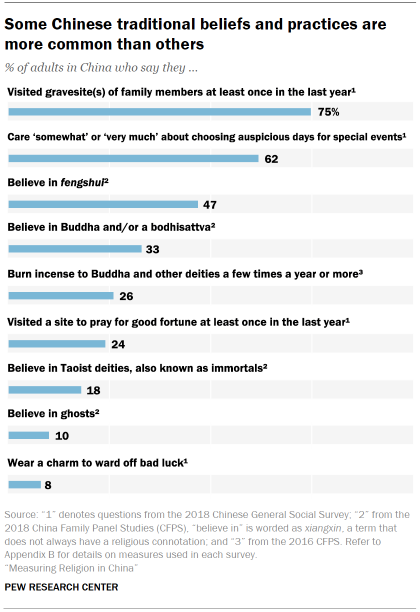
In Chinese religious tradition, supernatural beings typically include gods – or deities – and ghosts, i.e., the spirits of the dead. While the spirits of deceased ancestors fall into the category of “ghosts”(gui 鬼), Chinese people rarely use this term to describe their own deceased ancestors.
Gods, which are usually viewed as benevolent and having the power to intervene in worldly affairs, are believed to reside in heaven, Earth or the underworld. They follow a divine hierarchical structure and oversee a jurisdiction in accordance with their position. They may include Buddhist figures, Taoist immortals (shenxian 神仙) and local deities outside of the Buddhist or Taoist pantheons.
Gods can also be the spirits of human heroes. For instance, Lord Guan (Guan Gong 关公) was originally a renowned military general, Guan Yu (160-220 C.E.). He was worshipped by ordinary people as the god of war after his death, and later also by Confucian elites, who extolled Guan Yu as a moral exemplar of loyalty and honesty. Guan Yu was also granted the Buddhist rank of bodhisattva during the Sui dynasty (581-618), and the Taoist title of Emperor Guanduring the reign of Song Emperor Huizong in the 12th century.
Ghosts are often believed to possess the power to intervene in worldly affairs, but they can be malevolent and are of a lower rank than gods. Ghosts are usually confined to the underworld, except during the month of Lunar July, also known as “Ghost Month,” when the gate of the underworld opens and ghosts are allowed to visit the world of the living. It is believed that making food offerings and burning “spirit money” can appease ghosts and prevent them from harming the living.
Belief in deities, including Buddha and/or a bodhisattva and immortals, is more common than belief in ghosts. For example, 18% of Chinese adults express belief in immortals, compared with 10% of adults who believe in ghosts, according to the 2018 China Family Panel Studies (CFPS).
Because some gods are venerated across religious traditions, it is not always clear which religion(s) such practices fall into. For instance, burning incense to pay respects to Buddha (shaoxiangbaifo 烧香拜佛) may appear to be a Buddhist practice, but this activity is found across Chinese religious traditions.25 Some people may burn incense to pay respects to Buddha while incorporating distinctly folk religion practices, such as simultaneously making wishes to Buddha.26 Likewise, it is unclear whether a person who says they believe in Buddha and/or a bodhisattva should be considered a Buddhist or a practitioner of folk religion.
Burning incense (shaoxiang 烧香) – usually incense sticks – is believed to open up communication with gods so they can more readily hear people’s wishes. It is an essential component of venerating or paying respects to deities and ancestors, and in Chinese folk religious traditions, burning incense is typically accompanied by making wishes (xuyuan 许愿). Today, the term shaoxiangbaifo is commonly used to describe the act of venerating one or more deities of traditional Chinese religions.
Roughly a quarter of Chinese adults (26%) say they burn incense – at home or in temples – to pay respect to Buddha or deities a few times a year or more, including 11% who do so at least once a month, according to the 2016 CFPS.27 And 24% say they visited a particular destination – typically a temple or shrine – to pray for good fortune in school, business or other matters in the past year, according to the 2018 CGSS.
These measures suggest that most Chinese people are not frequently engaged in traditional religious activities. However, this low level of engagement is consistent with Chinese religious tradition, where people are not expected to pay respects to a god or gods regularly.
Rather, as some scholars have argued, religious engagement in China largely revolves around efficacy (ling 灵or lingyan 灵验) – how well a particular god or ritual responds to a person’s request – and believers are “consumers” who choose from the full array of gods and religious rituals when the need arises.28
Supernatural forces
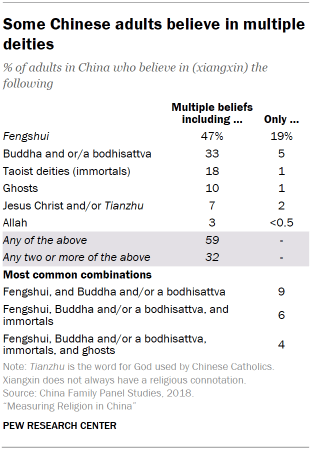
In Chinese religious tradition, apart from gods and ghosts, supernatural forces, such as fate (ming 命), fortune (yun 运) and fengshui may affect or even largely shape one’s life.29 While ming is predestined and immutable, yun changes. There are a variety of divination practices believed to bring good fortune or ward off bad luck, such as fengshui maneuvering – the practice of arranging objects to create harmony between individuals and their environment – wearing lucky charms, and selecting auspicious days for special occasions.30
Chinese people commonly describe these practices as custom or superstition (mixin 迷信), though they are known to have Taoist underpinnings. It is not always clear whether the practice should be considered religious or which religious tradition it falls under. For instance, some people may consider their fengshui practice to be scientific, while others may hire Taoist priests to perform fengshui activities in a folk religious way, and still others may practice it in a purely Taoist way, as part of Taoist health rituals.
Approximately six-in-ten adults (62%) say they care “somewhat” or “very much” about choosing an auspicious day for special occasions, according to the 2018 CGSS. Almost half (47%) believe in fengshui, according to the 2018 CFPS. And 8% of Chinese adults say they carry a lucky charm or amulet to bring good fortune or keep them safe from harm.
Mixing of beliefs and practices
Traditional Chinese religious or spiritual beliefs and practices are not mutually exclusive. Beliefs in Buddha and/or a bodhisattva, immortals and fengshui overlap considerably, and few Chinese hold only one belief. For example, just 5% of adults say they believe in (xiangxin 相信) Buddha exclusively, compared with 9% of adults who say they believe in Buddha and/or a bodhisattva and fengshui at the same time. An additional 6% also believe in Taoist immortals.

There are significant differences on these belief and practice measures across demographic groups. On average, women, older adults and people with less educational attainment tend to be more engaged in folk religion.
For example, women are consistently more likely than men to say they burn incense to venerate Buddha or other deities. They are also more likely to believe in folk deities, fengshui and auspicious days. However, women are less likely to visit the gravesite(s) of family members, as men are primarily responsible for performing that ritual, according to custom.
Affiliation
The share of Chinese adults who describe their religion (zongjiao) as Confucianism, Taoism or folk religion is much smaller than the share who engage with beliefs and practices from these traditions.
The most common of these identities is folk religion, but still, only about 3% of adults in China identify as adherents of folk religions, according to the 2018 CGSS.31
The CGSS is the only national survey that includes “folk religion” in the religious affiliation question, and it presents worshipping Mazu (妈祖), the goddess of sea, or Guan Gong (关公), commonly venerated as the god of wealth, as examples of folk religion.
The CGSS question may not capture some adults who worship other folk deities, such as the goddess of mercy (Guanyin 观音), earth gods (tudigong 土地公), dragon king (longwang 龙王) or Silkworm Mother (Cangu Nainai 蚕姑奶奶).
Some Chinese people who engage in deity worshipping may not consider themselves religious in the formal sensebecause folk religion is commonly regarded as superstition in China, which the government discourages.
In addition, scholars have noted that practitioners of folk religion sometimes refer to all forms of folk religion as Buddhism and claim Buddhist affiliation, even though they mostly practice folk religion. (Read Chapter 3 for details on Buddhism in China).32
Many people in China do not consider Confucianism to be a religion. This report does not analyze Confucianism as a religious affiliation, and we do not make any estimate of the number of Confucians in China. Taoism is one of the five religions recognized by the government (along with Buddhism, Catholicism, Islam and Protestantism), but very few Chinese adults identify as Taoists in the 2018 CGSS.33
Sidebar: How many Buddhist, Taoist, Confucian and folk religious sites are there in China today?
For various reasons, it is unclear exactly how many traditional Chinese worship sites (temples and shrines with Buddhist, Taoist, Confucian or folk religious elements) there are across China today. Nor is it clear which sites are most common. This sidebar describes the government’s official statistics as well as some unofficial estimates based on surveys of “neighborhood committees,” explaining why neither set of numbers is wholly reliable.
Official data
Chinese government statistics show a total of 43,000 temples – about 34,000 Buddhist sites and 9,000 Taoist sites – across the country as of 2018. However, this count covers only officially registered Buddhist and Taoist venues, which typically include a monastery or housing for monks or nuns, as well as a prayer hall that is open to the public for worship.
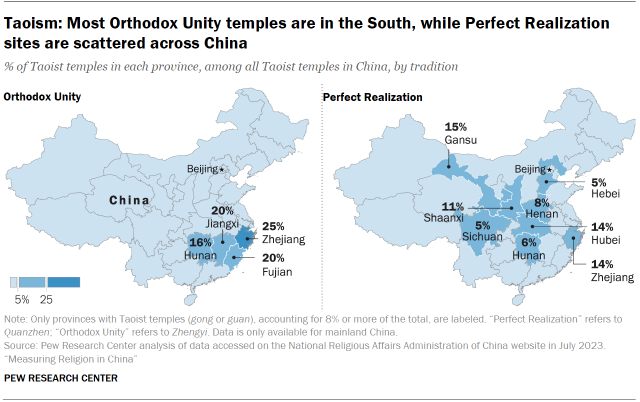
Buddhist temples (si 寺 or siyuan 寺院) included in the official statistics are categorized based on their school: Han, Tibetan or Theravada. (Refer to the Buddhism chapter for more details.) Taoist temples (gong 宫 or guan 观) are usually classified as belonging either to the Perfect Realization tradition (Quanzhen 全真) or to the Orthodox Unity tradition (Zhengyi 正一).34 According to the official figures, somewhat more Taoist temples belong to Orthodox Unity (4,338) than to Perfect Realization (4,011).35 Also, the Perfect Realization tradition has a stronger presence in northern China, while Orthodox Unity tends be more widespread in southern regions, according to data from the National Religious Affairs Administration of China.
Buddhist or Taoist sites without formal registration are excluded from the official statistics. It is possible that the number of unregistered Buddhist and Taoist sites far exceeds those registered, given the high bar for registration, such as having steady income and qualified clergy. In addition, the managers of many sites may have little incentive to register, because local authorities often permit unregistered Buddhist or Taoist venues to operate without much difficulty.36
Meanwhile, folk religion sites – which are mostly shrines and temples– are not tracked closely by the government since folk religion is not one of China’s five official religions and does not have its own supervisory agency.
In 2015, the Chinese government issued, for the first time, a national document urging local governments to regulate folk religion and its sites. However, registration requirements for folk religion sites vary widely by province. For instance, in Guangdong province, any folk religion site seeking to register must have a minimum building area of 500 square meters (5,382 square feet), while in Hunan province, the requirement is just 50 square meters. These inconsistencies add to the challenge of estimating the number of folk religious sites across China.
Although Confucianism is not officially recognized by the government as a religion, there is a national association that tracks Confucian temples (wenmiao 文庙 or kongmiao 孔庙). Traditionally, these were sacred places reserved for educated elites to worship Confucius. Today, they are open to all visitors. Government statistics show 1,600 Confucian temples across China. However, this count does not include ancestral halls or temples (zongci 宗祠 or citang 祠堂) – places of worship dedicated to ancestors of the same family lineage, which are closely tied to Confucianism.
Estimating numbers of worship sites from surveys of local jurisdictions
Survey data provides an alternative way to estimate the prevalence of traditional religious sites. The 2014 China Labor-force Dynamics Survey (CLDS) of neighborhood committees – the smallest administrative unit in China – indicates that 35% of such committees have in their jurisdiction at least one temple or shrine associated with traditional Chinese religions, such as a temple with a Buddhist connection (simiao 寺庙), a Taoist temple that includes a monastery (dao guan 道观), an ancestral hall (zongci or citang), or a folk temple dedicated to an earth god (tudi ci 土地祠) or shrine dedicated to other local deities (shenkan 神龛).
All told, the CLDS data suggests there may have been as many as 280,000 traditional worship sites in China in 2014.37 However, that figure also may be low. Although the survey asked about the presence of temples without specifying their registration status, it is possible that neighborhood committees reported only temples that had received some type of government approval, such as formal registration or at least tacit consent from local officials.
Ancestral halls
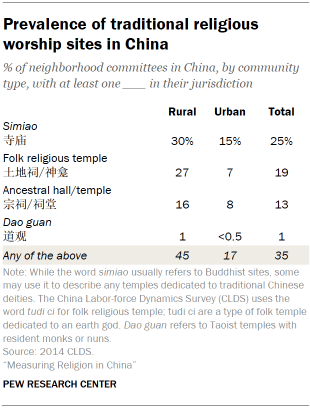
The CLDS report on neighborhood committees shows that about 13% of such committees have in their jurisdiction at least one ancestral hall (zongci or citang). Neighborhood committees in rural areas, known as “villagers’ committees,” are particularly likely to have at least one site dedicated to ancestors (16%). A neighborhood committee generally represents between 1,000 and 3,000 households, while a villagers’ committee is comprised of an average of around 370 households.38
These numbers suggest there are more than 102,000 ancestral halls in China. But this may be a conservative estimate, because 7% of neighborhood committees report having two or more ancestral temples in the survey.
Buddhism
CLDS data indicates there were more than 190,000 Buddhist temples (simiao) in China, far greater than the government’s count of 34,000 officially registered Buddhist sites. However, that 190,000 figure could overstate the number of Buddhist venues with a monastery, because the term “simiao”is also sometimes used to describe any temple or shrine that houses Buddhist deities along with various other traditional Chinese religious deities.
Taoism
As for Taoist temples, CLDS data indicates that only 1% of neighborhood committees have at least one such temple in their jurisdiction. However, this count is based on a survey question asking about dao guan, which are temples with resident Taoist monks or nuns. It does not account for worship sites with some looser Taoist connection, such as temples or shrines that house Taoist deities along with various other traditional Chinese religious deities.
Folk religion
Folk religious temples, measured by the presence of temples (tudi ci) or local shrines (shenkan), seem to be relatively common in China, being present in 19% of neighborhood committees, according to the 2014 CLDS. Neighborhood committees in rural areas are particularly likely to have a site dedicated to local folk deities (27%). However, not all folk religious sites are dedicated solely to local folk deities, national heroes, trade gods, and/or other so-called “tutelage” or protector gods (such as the mountain god). In fact, it is common for folk religious temples also to house Buddhist or Taoist figures.
As a result, the CLDS-based estimate that there are at least 165,000 folk temples (tudi ci) or local shrines (shenkan) might not count some sites that house Buddhist or Taoist deities together with folk deities, thus leading to a possible undercount of folk religious sites in China.
Furthermore, while the CLDS data may seem to suggest that Buddhist temples are the most common variety in China, this conclusion may not be warranted, due to the complex interconnections of Buddhism, Taoism and folk religion. Some temples or shrines may not fall neatly under one religious category, because they house multiple Buddhist, Taoist and folk deities at the same time.
There is some evidence suggesting the number of temples that fall outside of official statistics declined in the past decade when local authorities tightened controls over folk religion. For example, in Zhejiang, 35,000 folk religious sites were listed in 2013, but that number dropped by half to 17,000 in 2020 as sites that failed to meet the government’s registration requirement were demolished, closed or converted into secular facilities.
3. Buddhism
Buddhism (Fojiao 佛教) is the largest officially recognized religion in China. The share of Buddhists in China ranges from 4% to 33%, depending on the measure used and whether it is based on surveys that ask about formal affiliation with Buddhism or beliefs and practices associated with Buddhism.
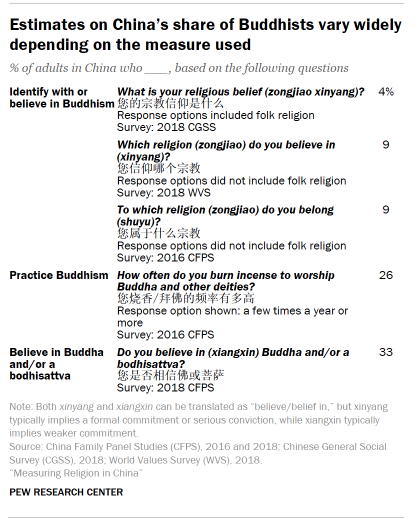
The share of Chinese adults who formally identify (zongjiao xinyang 宗教信仰) with Buddhism is about 4%, representing about 42 million adults, according to the 2018 Chinese General Social Survey (CGSS).39
But 33% of Chinese adults, representing about 362 million adults, believe in (xiangxin 相信) Buddha (fo 佛) and/or a bodhisattva (pusa 菩萨), according to the 2018 China Family Panel Studies (CFPS) survey – though this number also includes many people who believe in other religious figures as well, such as Jesus Christ or Taoist immortals.40
Buddhism in China has three main branches. Han Buddhism, or Chinese Buddhism, accounts for the vast majority of the country’s Buddhists, as measured by the number of registered temples. (Refer to “Geographic distribution of Buddhist temples” for more detail.)
Tibetan Buddhism and Theravada Buddhism are practiced primarily by ethnic minorities in the Tibetan Plateau, Inner Mongolia and along the southern borders with Myanmar, also called Burma, and Laos. In China, the word “Buddhism” typically refers to Han Buddhism.
Although Buddhism originated in India, Han Buddhism has developed distinctly Chinese characteristics while also influencing older Chinese belief systems. Han Buddhists generally espouse the Confucian ideal of filial piety (xiao 孝) and have adopted practices that align with ancestor worship, such as praying for the well-being of deceased ancestors.45 They also have incorporated the Taoist practice of breathing exercises.
In the past decade, government policies have been relatively lenient toward Han Buddhism. President Xi Jinping has extolled (Han) Buddhism as one of the essential forms of Chinese traditional faith with a role to play in restoring morality, and has commended it for having “integrated … with the indigenous Confucianism and Taoism.”
How many Buddhists are there in China?
As with Taoism and folk religion in China, assessing the size of the Buddhist population is challenging due to Buddhism’s blurry boundaries with other traditional Chinese religions. Unlike Christianity and Islam, Buddhism does not require exclusivity of belief or practice. Buddhists do not need to affiliate with a local temple or Buddhist association, nor must they participate in the formal ritual of “taking refuge” (guiyi 皈依) to identify with Buddhism.
As a result, survey questions that measure Buddhist self-identification (i.e., “What is your religious belief?” “Which religion do you believe in?” and “To which religion do you belong?”) fail to capture adults who engage in Buddhist beliefs and/or practices but do not consider themselves formally affiliated with Buddhism. Survey questions that ask about Buddhist affiliation tend to produce much lower estimates than those that ask about belief in Buddha and/or a bodhisattva, or about the burning of incense to pay respects to Buddha and other deities (shaoxiangbaifo 烧香拜佛).
That said, belief and practice measures are not a wholly accurate proxy for Buddhist identity, either. Because of Buddhism’s embeddedness in Chinese folk religion, seemingly Buddhist measures are not exclusively Buddhist, and may also capture folk religion practitioners. For instance, the Buddhist figure of Avalokiteśvara, a bodhisattva often depicted as genderless or male, has evolved into an important folk deity, the goddess of mercy (Guanyin 观音), which makes it unclear whether a person worshipping a bodhisattva is a Buddhist or a practitioner of folk religion. (Refer to Chapter 2 for a discussion of how Buddhism intertwines with other Chinese religious traditions.)
Meanwhile, Chinese people sometimes do not distinguish between certain concepts in folk religion and Buddhism. In southern Fujian, for example, people commonly refer to all types of folk religion as Buddhism (Fojiao 佛教).46 In other words, some people who primarily practice folk religion may choose “Buddhism” as their religious belief (zongjiao xinyang) in surveys, especially when “folk religion” is not offered as an option. Indeed, surveys that give respondents the option to self-identify with “folk religion” tend to produce lower Buddhist estimates than those that do not offer “folk religion” as an option.
Moreover, there is a varied understanding of what it means to “be Buddhist.” Some Chinese who worship Buddha as one of many folk deities may describe themselves as “believing in Buddha” (xinfo 信佛), while those who are devoted to studying Buddhist scriptures may say they are “studying Buddha” (xuefo 学佛) or refer to themselves as “Buddha’s disciples” (fomen dizi 佛门弟子). Others may believe that only Buddhist monks and nuns should claim Buddhism as their zongjiao (宗教) or zongjiao xinyang.
While it may be possible to approximate the number of Buddhists based on the share of adults who engage in distinctly Buddhist rituals and activities – such as “taking refuge” and chanting Buddhist sutras – there is a shortage of data on these measures. The last publicly available national survey to ask questions about clearly Buddhist rituals and activities was the 2007 Spiritual Life Study of Chinese Residents, which found that only a small fraction of Chinese adults had undergone the formal ritual of conversion (2%), recited Buddhist prayers (1%) or occasionally read Buddhist scriptures (1%).
Even the Buddhist Association of China – the official supervisory agency for Buddhist affairs in China – provides population estimates that it says are based on “incomplete statistics” (bu wanquan tongji 不完全统计). In 2017, it estimated that China had more than 100 million Buddhists, equivalent to more than 9% of the adult population. How this estimate was derived is unclear.
Buddhist beliefs and practices
Belief in Buddha

Fully 33% of Chinese adults say they believe in (xiangxin) Buddha and/or a bodhisattva, according to the 2018 CFPS survey.47 This figure includes those who chose one or more additional deities from among the response options, such as “Taoist immortals,” “Jesus Christ,” “Catholic God” and “Allah.” The share of Chinese adults who say they believe in Buddha and no other deities is 16%.
Burning incense to worship Buddha (and other deities)
About a third of Chinese adults say in the 2016 China Family Panel Studies survey they burn incense to worship Buddha and other deities at least once a year (35%), including 26% who engage in such practice a few times a year or more. Again, questions about Buddha – such as those that measure belief in Buddha and/or a bodhisattva or the burning of incense to worship Buddha and other deities – are not distinctly or exclusively Buddhist. (Refer to discussion in previous section.)
Zongjiao affiliation

In the 2018 CGSS – which includes a “folk religion” option – 4% of Chinese adults said their zongjiao xinyang is Buddhism. Estimates of Buddhist affiliation from surveys that do not offer the folk religion option, such as the CFPS and World Values Survey (WVS), are as high as 9%.48
One advantage of the CGSS, which is the only survey that includes “folk religion” as a response option, is that it may help differentiate Buddhists from folk religion practitioners who might otherwise choose the “Buddhism” response option. Another advantage of the CGSS is that it measures formal affiliation with Buddhism using similar methods across waves, and it produces Buddhist estimates that do not swing dramatically between waves. The CGSS estimate of the Buddhist population is conservative relative to the other sources, and it seems to trend slightly downward over time.
The WVS and CFPS each have only two publicly available datasets with a consistent measure of Buddhist affiliation. They provide less information about change over time than the CGSS.
As discussed earlier, zongjiao-focused questions do not capture the full scope of traditional Chinese religions, including Buddhism. Still, zongjiao affiliation measures provide useful context.49
Not surprisingly, surveys show that adults who claim Buddhism (Fojiao) as their religion (zongjiao) tend to be more actively engaged in zongjiao religious practice than those who believe in (xiangxin) Buddha and/or a bodhisattva, and they are also more likely to consider zongjiao very important in their lives, according to the CFPS.50
Geographic distribution of Buddhist temples
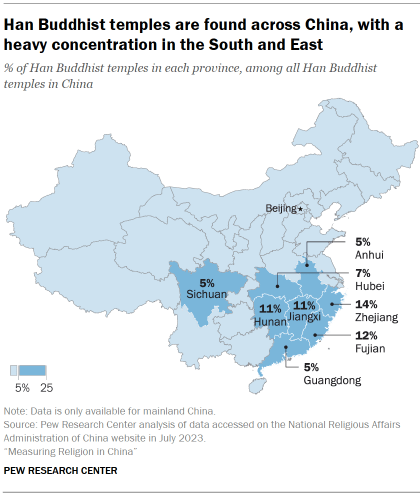
In China, Buddhist temples are known as si (寺) or siyuan (寺院). They often consist of several buildings, including a monument housing a sacred Buddhist relic as well as a monastery or housing for monks or nuns, and a prayer hall that is open to the public for worship.
Simiao (寺庙), which is another term for Buddhist temples, can also refer to any temples or shrines that house Buddhist deities, along with various other traditional Chinese religious deities.
The National Religious Affairs Administration (NRAA), which measures officially registered Buddhist temples with a monastery, found that there are about 34,000 such venues in China.51 Han Buddhist temples are most common (28,528), followed by Tibetan (3,857) and Theravada (1,705) temples.
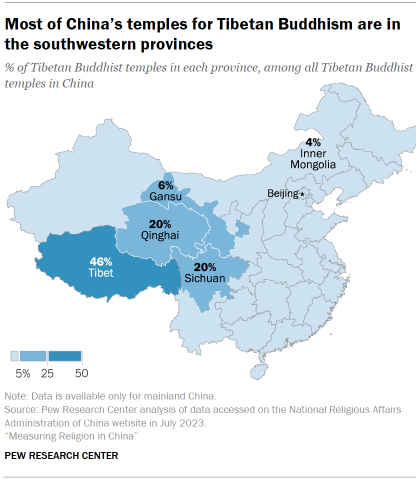
However, these numbers do not include unregistered Buddhist temples. To be officially registered, religious venues in China must meet specific requirements, including having a steady income and qualified clergy. Some temple managers may have little incentive to register because local authorities often permit unregistered Buddhist temples to operate normally (even though they crack down on unregistered churches.)52
Moreover, official statistics fail to count some folk temples (miao 庙) that also house Buddhist deities along with various other traditional Chinese religious deities.
The 2014 China Labor-force Dynamics Survey (CLDS) of neighborhood committees – the smallest administrative unit in China – which asks neighborhood committee staff about the presence of Buddhist temples (simiao) in their jurisdiction, indicates that temples with some type of Buddhist connection are far more common than NRAA data indicates.
A Pew Research Center analysis of the 2014 CLDS suggests that there are at least 192,000 such temples (simiao) dedicated at least partially to Buddhist deities in China, more than five times the officially registered number of Buddhist temples. Officially registered temples usually have resident monks and nuns, which is not necessarily true for unregistered temples. (For more on other types of traditional Chinese worship sites, refer to the “How many Buddhist, Taoist, Confucian and folk religion sites are there in China?” sidebar.)
According to NRAA, Han Buddhist temples are widespread throughout the country, with a heavy concentration in the southeastern provinces of Zhejiang, Guangdong, Fujian, Hunan, Hubei and Jiangxi. This concentration is likely tied to higher rates of economic development in these areas, which may have helped accelerate temple construction and repairs after the Cultural Revolution.
Tibetan Buddhist temples are largely confined to the southwestern region known as the Tibetan Plateau, which encompasses the Tibet Autonomous Region established by the Chinese government in 1965, as well as portions of the neighboring provinces of Sichuan and Qinghai. (In this report, Tibet refers to the Tibet Autonomous Region.) Nearly 86% of China’s Tibetan Buddhist temples are found in Tibet, Sichuan and Qinghai.
All Theravada Buddhist temples registered with the NRAA are found in the southwestern Yunnan province, particularly in areas heavily populated by Dai people, such as Xishuangbanna prefecture.
4. Christianity
There is a range of estimates for the number of Christians in China, partly because different researchers use varying sources and methods, and partly because some analyses make adjustments to account for limitations in survey and government data.53
One perspective is provided by responses to the Chinese General Social Survey (CGSS) question “What is your religious belief (zongjiao xinyang 宗教信仰)?” In 2018, the CGSS found that roughly 2% of Chinese adults, or about 20 million people, self-identify with Christianity in this way.54 According to this survey, Protestants account for roughly 90% of Chinese Christians, or about 18 million adults, while the remainder are mostly Catholics. Smaller groups, which include Orthodox Christians, are fewer than 1% of Christian adults in China.55
Other national surveys, which use slightly different question wording, report similar shares. In the 2018 World Values Survey, 2% of Chinese adults said they believe in (xinyang 信仰) Christianity, and in the 2016 China Family Panel Studies (CFPS) survey, 3% said they belong to (shuyu 属于) Christianity.
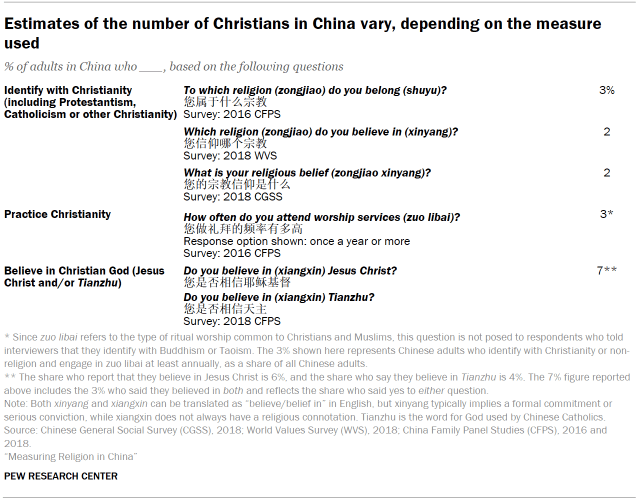
Some media reports and academic papers have suggested the Christian share may be larger, with estimates as high as 7% (100 million) or 9% (130 million) of the total population, including children. No national surveys that measure formal Christian affiliation – by asking people which religion (zongjiao) they identify with – come close to these figures.
However, survey questions that measure Christian beliefs and practices provide evidence that the number of people with some connection to Christian faith is greater than zongjiao measures reveal.
For example, the cumulative share of Chinese adults who say they “believe in” (xiangxin) Jesus Christ and/or Tianzhu (天主, the word Chinese Catholics use for God) is 7%, or roughly 81 million adults, according to the 2018 CFPS survey.
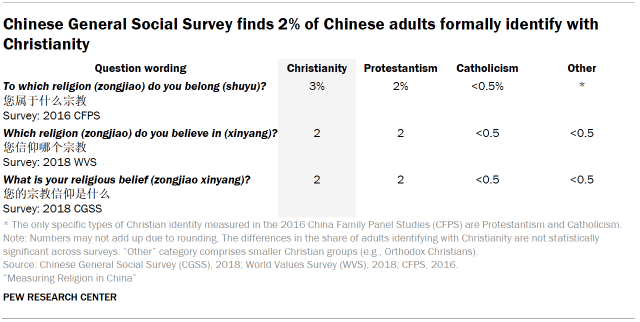

Some scholars argue that this measure may be a better alternative than zongjiao xinyang, citing a core Christian teaching that one should never deny belief in God (including Jesus Christ or Tianzhu) regardless of the circumstances.56
But these figures encompass those who also believe in one or more non-Christian deities, such as Buddha and/or a bodhisattva, immortals (Taoist deities) or Allah. The share of Chinese adults who say they believe in Jesus Christ and/or Tianzhu and do not believe in these other deities is about 3%.
Challenges of measuring Christianity in China
Political sensitivity
Counting Christians in China is difficult for several reasons. Officially, only churches authorized by the government are allowed to operate. But, in reality, many Christians worship in unauthorized venues known as “underground churches” (dixia jiaohui 地下教会) or “house churches” (jiating jiaohui 家庭教会). These Christians may be reluctant to reveal their identity. Likewise, members of the Chinese Communist Party, who are prohibited from holding a religious affiliation, might not disclose their Christian affiliation.57
In recent years, the government has tightened control over Christian activities outside of registered venues, banned unauthorized evangelization online, and intensified its crackdown on unauthorized Protestant meeting points and underground Catholic churches, making Christianity a very sensitive topic in China. In addition, President Xi Jinping has called for the “Sinicization of religions,” a strategy that particularly affects non-traditional belief systems, including Christianity and Islam.
(For more, read the Methodology section “Exploring the underreporting of zongjiao affiliation in Chinese surveys” and discussion of Xi Jinping’s Sinicization campaign.)
Self-identification versus belief and practice
Measuring Christianity in China is also difficult because, as discussed in other chapters, conventional measures of self-identification based on zongjiao do not fully capture the breadth of religious experience in China. And even though Christianity and Islam, unlike Buddhism or folk religions, emphasize exclusivity in belief and practice, many Chinese who engage in Christian practice or even consider themselves to be worshippers of Jesus Christ or Tianzhu may not necessarily identify with Christianity when asked about their zongjiao xinyang.
Looking cumulatively at the broadest, most inclusive survey measures of Christian affinity, as many as 8% of Chinese adults have some degree of connection to Christianity because they formally identify as Christian, believe in the Christian God or report a type of worship attendance common to Christians.
In other words, a broad approach to measuring Christian affinity generates a considerably larger estimate of the number of people with some connection to Christianity than the much smaller share who say Christianity is their zongjiao.
Sampling issues
Sampling coverage, which is tied to the geographic concentration of China’s Christians, may affect the accuracy of Christian estimates. Roughly a quarter of China’s Catholics live in the northern province of Hebei, and they tend to cluster in rural “Catholic villages,” where the vast majority of residents follow Catholicism.58 As a result, Catholic survey estimates may vary depending on how many such villages are included in the sample. Similarly, it is consequential whether Protestants are proportionately represented. For example, surveys may yield a slightly lower Protestant estimate if Wenzhou – said to be the most Christian city in China – is excluded from the sample.
Some researchers argue that surveys that undersample ethnic minority groups may undercount Christians. However, the minority groups in question are relatively small in proportion to China’s population, and Bible distribution figures suggest they make up a small fraction of all Chinese Christians.59
Recent change in Christian measures
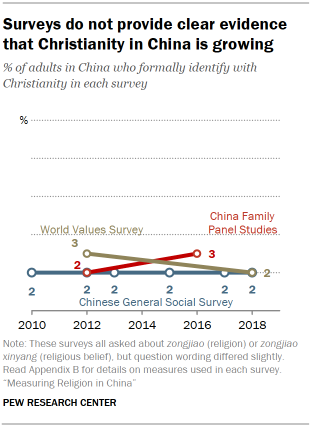
Some scholars and journalists have argued in recent decades that Christianity in China is growing rapidly. Indeed, Christianity flourished after China entered an era of economic reforms and “opening up” to the world in the 1980s. But recent surveys that measure zongjiao affiliation do not offer much evidence that Christian growth continued after 2010.
According to the CGSS, about 2% of adults (23.2 million) in China self-identified as Christian in 2010, versus 2% (19.9 million) in the 2018 survey – a gap that is not statistically significant.60 (In the 2021 CGSS, 1% of respondents identified as Christian. However, this wave did not cover as many regions as previous waves of the CGSS, so the results may not be directly comparable.61)
Since measures of Christian belief and practice have not been repeated consistently in surveys, we cannot track how beliefs and practices associated with Christianity have changed since 2010 in the Chinese public. We don’t know, for example, whether overall belief in Jesus Christ or attendance at Christian worship services (zuo libai 做礼拜) has risen, declined or remained stable.
One of the few repeated survey measures of religious commitment is the broad measure of zongjiao activity, which has been included in all recent CGSS waves. Among those who identify as Christian, reports of zongjiao activity levels are roughly stable. In 2010, 38% of Christians said they engaged in zongjiao activities at least once a week, while in 2018, 35% said so – a difference that is not statistically significant.
Unfortunately, we cannot be certain how survey patterns are affected by political circumstances. There could be a real increase in the share of Chinese adults who identify with Christianity that is hidden from survey measurement. For example, it is possible there has been growth in Christian affiliation that is offset in surveys by growing reluctance among respondents to identify as Christian due to the government’s intensifying scrutiny of Christian religious activity. While that is a hypothetical possibility, there is no way to know from the available survey data whether it is actually the case.
It is also possible that the share of Christians who do not reveal their identity in surveys may have remained roughly stable since 2010. In that case, the apparent leveling off (“plateau”) in Christian identification in recent surveys could be an accurate reflection of the overall pattern, even if surveys fail to capture the full number of Chinese Christians.
Traits associated with formal Christian affiliation
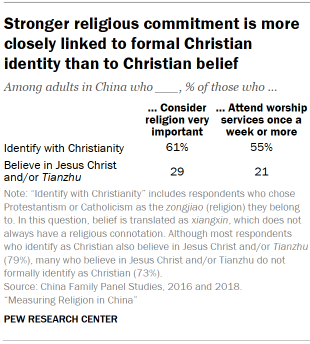
While survey questions that ask about formal zongjiao affiliation have limitations, they capture a subset of Christians who are more religious by several measures than those who say they believe in Jesus Christ and/or Tianzhu.
According to data from the 2016 and 2018 CFPS surveys, 68% of adults who self-identify as Christians believe in Jesus Christ and/or Tianzhu exclusively (i.e., without believing in other deities, including Buddha and/or a bodhisattva, immortals or Allah).62
By contrast, among all those who say they believe in Jesus Christ and/or Tianzhu, only 40% indicate they hold this belief exclusively.

Adults who formally identify with Christianity also are more likely to say religion (zongjiao) is very important in their lives than are those who say they believe in Jesus Christ and/or Tianzhu but do not necessarily formally identify with Christianity (61% vs. 29%), according to the CFPS. And they are more likely to say they attend worship services once a week or more (55% vs. 21%).
According to the 2018 CGSS, respondents who choose Christianity as their zongjiao xinyang are older and have lower educational attainment than the average Chinese adult. The majority (72%) are women.
Christian houses of worship
There are two types of officially sanctioned Protestant places of worship in China: churches (jiaotang 教堂) and meeting points (juhuidian 聚会点). A meeting point is not different from a church functionally, but it may not look like a church building; it can be an apartment or office space and usually holds fewer congregants.
For instance, Haidian Church in Beijing hosts an average of roughly 7,000 people for worship services, while its affiliated meeting points each hold between 150 and 500 people.
In 2009, Protestant venues totaled 55,000 (including roughly 24,000 registered churches and 31,000 meeting points), according to the China Christian Council (CCC) and the Three-Self Patriotic Movement (TSPM). Since then, China’s Protestant supervisory agencies have not broken out churches and meeting points separately.63 According to China’s State Council Information Office, there were roughly 60,000 legal Protestant venues in 2018, largely unchanged from a total of 58,000 venues in 2009.64 These do not include Protestant house churches or unauthorized meeting points.
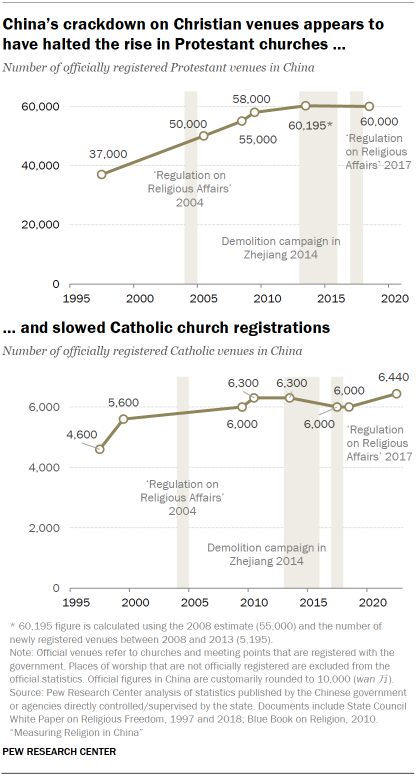
Not all registered meeting points are included in the official statistics of formally registered Protestant venues, a discrepancy that might be explained, at least in part, by the ambiguous meaning of the Chinese words for “register” (dengji 登记 or zhuce 注册). These words can mean either “granted formal registration” or “put on local government record.” The latter may not appear in official statistics.
For instance, Haidian Church in Beijing has more than 50 authorized meeting points, but the CCC and TSPM consider none of the affiliated meeting points a registered venue, even though some of them function much like independent churches, hosting their own worship services and baptisms.
The number of registered Protestant venues, which increased substantially between 1997 and 2008, has roughly leveled off since then.
After 2013, some Protestant churches in Zhejiang – the province with China’s highest concentration of officially registered Christian venues – were affected by the “Three Rectifications and One Demolition” campaign which led to the demolition of some officially sanctioned churches that violated zoning regulations. News reports indicate that officially registered churches later also were demolished in other provinces, including Anhui, Fujian, Henan and Shanxi.
Since 2017, following an update of the “Regulation on Religious Affairs,” authorities have been more strictly implementing policies on unauthorized religious activity. Their strategy has included putting more pressure on venues to affiliate with the TSPM and submit to government oversight, while cracking down on those that resist.
The government’s plan for unauthorized Protestant meeting points has not necessarily led to an increase in official venues, due in part to the ambiguous meaning of “register.” For example, in Tianjin, less than 10% of the total 643 authorized TSPM Protestant meetings have been granted a certificate of registration as of 2019. Similarly, Hohhot, the capital city of Inner Mongolia, has 480 authorized Protestant meeting points, but only 67 of them have been formally registered.
In addition, some scholars believe that local officials in China tend to underreport evidence of religious activity in order to appear compliant with the state’s goal to contain religion. For example, in the Fengxian district of Shanghai, local officials continued to refer to just 24 registered Christian worship sites in 2019, even though in 2018, they reported having accepted 73 (out of 86) unauthorized Christian sites into the official system.
For similar reasons, the trend in the number of registered Protestant clergy seems to conflict with recent government policy pushing for registration. Between 2009 and 2018, the number of official Protestant clergy (pastors, ministers and ordained elders) declined slightly from around 37,000 to 36,000. This trend also appears to conflict with the CCC and TSPM’s emphasis on training Protestant clergy for the official system; around 6,300 students graduated from theological seminaries between 2013 and 2018.
Catholic churches and relations with the Vatican
Government statistics on the numbers of officially registered Catholic venues and personnel – which include only those affiliated with the Catholic Patriotic Association (CPA) – point in slightly different directions.
On the one hand, the number of official Catholic personnel (bishops, priests and nuns) declined from 8,800 in 2009 to 8,000 in 2018. On the other hand, according to official statistics, the number of Catholic venues has grown slightly. In 2022, there were 6,440 officially registered venues (including 4,202 churches and 2,238 sites of worship), up from 6,000 in 2009. (Estimates of churches and worship sites for other years are unavailable.)
Like Protestantism, there are two branches of the Catholic Church in China: the official church and underground churches (dixia jiaohui 地下教会). The former refers to churches that have joined the CPA, which is controlled by the National Religious Affairs Administration, formerly known as the State Administration for Religious Affairs.
The Chinese government has always been wary of underground Catholic churches. Local authorities usually closely monitor covert Catholic activities and pressure priests and bishops to join the CPA as part of an ongoing program to “educate and convert underground Catholic forces.”
This division dates back to the 1950s purge of foreign influence, when the government expelled missionaries and urged Catholic churches to cut ties with the Vatican. Many Catholic laity and clergy who remained loyal to the Vatican carried their faith in secret. During that period, the government recruited several Vatican-ordained bishops to form the CPA and appoint bishops based on the principle of “self-election and self-ordination” (zixuanzisheng 自选自圣) independently of the Vatican.
Underground churches are made up of clergy and laity who reject China’s authority to select bishops and insist on loyalty to the Vatican, while CPA churches pledge loyalty to the Chinese government and espouse the principle of zixuanzisheng.69 As of 2018, there were seven CPA bishops whom the Vatican had not approved, and an estimated 30 to 40 underground bishops whom the Chinese government did not recognize.70
In 2018, China’s relationship with the Vatican was recalibrated when the Vatican signed an agreement allowing the Chinese government to appoint bishops while giving the pope veto power. Since then, Pope Francis has recognized seven previously excommunicated “self-elected and self-ordained” Chinese bishops, while China has appointed eight underground bishops as CPA clergy, bringing the total number of bishops to 66 as of 2022.
Since signing the deal with the Vatican, the government has stepped up efforts to bring Catholic churches into the CPA and intensified its pressure on those that refuse to join.
Geographic distribution of churches
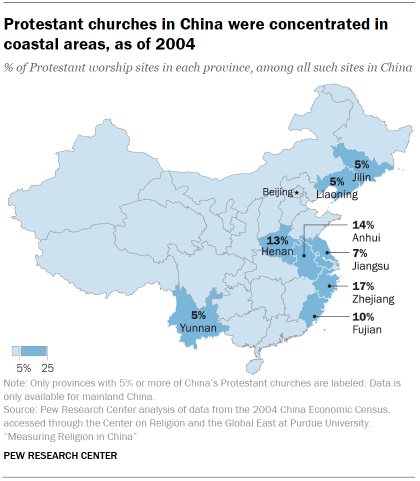
The most recent data on the distribution of Christian worship venues in China is from the 2004 National Economic Census, which shows that Protestant and Catholic churches were concentrated in coastal areas, reflecting the arrival of Christian missionaries by sea.71
(Even though the number of officially registered Protestant and Catholic churches has almost quadrupled since the 2004 enumeration, the data still offers a valuable snapshot of geographic patterns.72)

In 2004, Protestant churches were most numerous in the eastern coastal province of Zhejiang (with a 17% share of all Protestant churches in China), followed by the central province of Henan (13%). Zhejiang is home to Wenzhou city, often called “China’s Jerusalem,” while Henan is known as “the Galilee of China.” These distribution patterns may have changed because in 2013 several provincial governments started increasing demolitions of “illegally constructed” churches to curb Christianity’s public presence. Zhejiang was particularly affected.
Catholic churches were most numerous in the northern province of Hebei (13%), home to about a quarter of China’s Catholics, followed by the coastal regions of Fujian (12%) and Zhejiang (12%).
Sidebar: How the number of Protestants, Catholics in China has changed
Over the past decade, some Western scholars and journalists have claimed that Protestant Christianity is booming in China. Some data from the Chinese government and Christian organizations seem to support these claims. However, a closer examination raises questions.
Government estimates
The Chinese government, which has been publishing statistics on Christians sporadically since 1949, estimates that the number of Protestants may have grown from 700,000 in 1949 to 38 million in 2018. However, the 1949 and 2018 numbers do not seem to be directly comparable, because the Chinese government has changed its sourcing and methodology without making appropriate adjustments, and it does not always state whether children are included.73
It also is unclear to what extent the jump from 2008 (20 million) to 2016 (28 million) is driven by new converts or by recategorizing Christians who previously worshipped in unregistered churches. Since 2008, the CCC and TSPM have been carrying out a program of “connecting unauthorized meeting points with an official church” (yitangdaidian 以堂带点) as a new way of regulating unauthorized churches. Under this program, unauthorized meeting points whose leaders agree to affiliate with an official church gain legal status, as they are now considered a branch of a registered church. In other words, an official church could see its membership grow not only through conversion but also by taking in previously unauthorized meeting points.74
Below is a table summarizing all the official estimates of China’s Protestant population that Pew Research Center has found, along with corresponding notes about their origin and what they include.
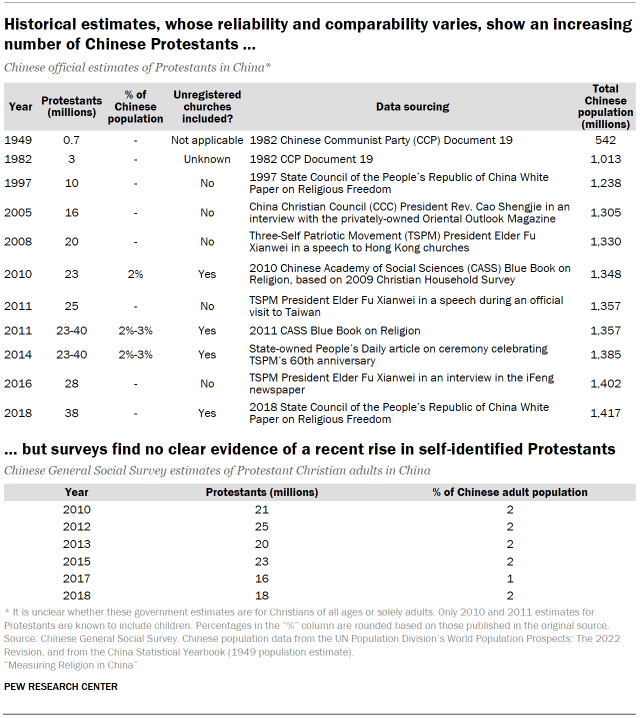
Claims by advocacy groups
International nonprofit organizations and advocacy groups also have published data claiming that Protestants in China have increased sharply. For example, the U.S.-based interdenominational Christian ministry Asia Harvest estimates there were 109.7 million Protestant Christians of all ages in China in 2020 (8% of the country’s total population), up from an estimated 86.9 million (6% of the population) in 2010.75 Asia Harvest’s assessment is based on a secondary analysis of published sources (including government estimates) and interviews with leaders of unregistered churches who granted its research team access to their membership statistics. Asia Harvest may have overcounted Protestants in the official system. Its 2020 estimate of 39.8 million TSPM Protestants is larger than both the 2016 government estimate of Protestants in registered churches (28 million) and the 2018 government estimate of Protestants in registered and unregistered churches (38 million).
Meanwhile, qualitative research points in various directions. On the one hand, CCC and TSPM leaders and senior clergy tend to agree that many rural churches are losing members and revenue because young people are leaving for city jobs.76 (In 2022, China had 296 million such migrant workers, according to China’s National Bureau of Statistics.) On the other hand, many urban churches seem to be thriving, with official churches reportedly becoming crowded and house churches expanding their worship sites to accommodate an inflow of rural Christians.77 In particular, some scholars consider the rise of “newly emerging urban churches” – whose members are often young and highly educated professionals and sometimes returnees from study abroad – an important indicator of Chinese people’s increased interest in Protestantism.78
That said, church membership is not a reliable indicator. For one thing, membership rosters may double-count migrants who have been enumerated both by their rural “home” church and their “receiving” church in the city. Church rosters may also fail to account for members leaving Christianity. An analysis of Christian identification over time using China Family Panel Studies (CFPS) data suggests significant flows both into and out of Christianity.
Among adults who identified with Christianity (3%) in the 2016 CFPS, about a third had not claimed Christianity as their religion when they were previously interviewed in 2012, suggesting that roughly 1% of Chinese adults converted to Christianity between the two survey years.
Meanwhile, among adults who identified with Christianity (2%) in the 2012 CFPS, about a quarter no longer did when asked again about their religion in the 2016 survey. And roughly one-in-five of the adults who self-identified as Christian in 2012 claimed no belief in either Jesus Christ or Tianzhu when reinterviewed in 2018. In other words, while many Chinese people convert to Christianity, some Chinese Christians apparently also leave the faith.
Are Catholics declining as a share of China’s population?
While there are conflicting signals about the trajectory of China’s Protestant population, all available sources suggest that China’s Catholic population is not growing. It is unclear whether the trends are influenced by a possible reluctance among Catholics to identify themselves or engage in church activities, given the impasse between China’s government and the Vatican in the years before a seminal rapprochement in 2018.
According to government figures, the number of people associated with the state-approved Catholic Church held steady at roughly 6 million (less than 0.5% of China’s population), between 2010 and 2018.
Baptism statistics from the church-run Faith Press (Xinde She 信德社) indicate that the numbers of people entering Catholicism may be declining. From the early 2000s to 2010, state-approved churches baptized approximately 100,000 people each year (mostly adults, as children under 18 are not allowed to convert to any religion). By 2017 and 2018, the annual number of Catholic baptisms had fallen by half, to about 48,000.
Data on mainland China that includes “underground” Catholics, gathered by the Holy Spirit Study Centre (HSSC) in Hong Kong, also indicates a decline. According to their analysis, the number of Catholics in China peaked at 12 million in 2005 and slipped to 10 million by 2020. Consistently, the estimated number of ordinations, religious vocations, seminarians and sisters in both official and underground Catholic churches also fell during this period.
In addition, Asia Harvest’s study, which typically produces higher Christian estimates than other sources do, suggests little growth of Catholicism in China. According to Asia Harvest, the number of Catholics remained steady at about 20 million between 2010 and 2020. This includes about 8.3 million people affiliated with the official Catholic Patriotic Association and 11.7 million Catholics outside officially recognized churches.
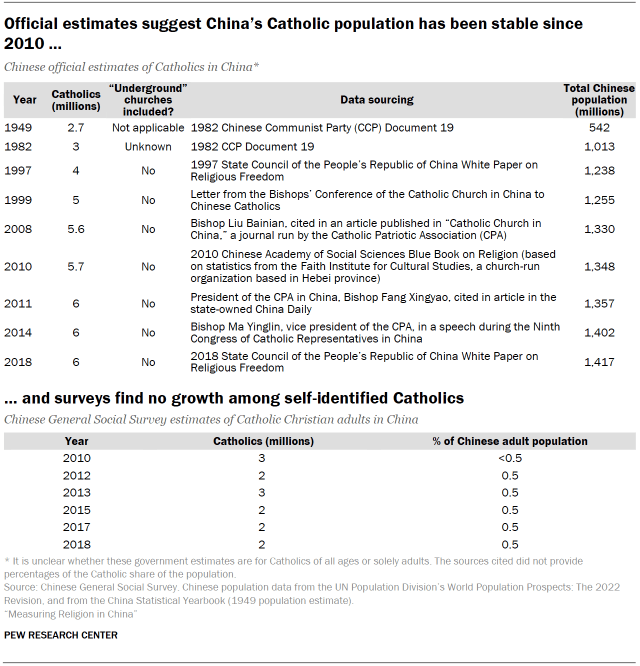
5. Islam
The vast majority of Chinese Muslim adults come from 10 ethnic minority groups that traditionally practice Islam, the two largest being the Hui people and the Uyghur people. Most of China’s Muslims live in the country’s northwestern region, particularly in the areas of Gansu, Qinghai, Ningxia and Xinjiang.

Because there is heavy overlap between religion and ethnicity among these minority groups, there is less uncertainty about the size of China’s Muslim population than there is about some of its other religious groups, such as Buddhists and Christians.
Chinese authorities and international scholars generally estimate there are 18 million Muslim adults in China. Pew Research Center’s estimate is in the same ballpark but slightly lower, at about 17 million, for reasons discussed below.
Notwithstanding the relative consensus around Muslim population numbers, studying Islam in China comes with many challenges. To begin with, the Chinese government has been accused by international organizations of human rights abuses and genocide against Uyghurs and other Muslims. Some Chinese Muslim scholars have reportedly been detained, while some foreigners who study Islam in China have been barred from traveling to the country.
In this climate, Chinese Muslims may hesitate to discuss their religious identity, beliefs or practices with survey researchers, and some may have moved away (or been pushed away) from their traditional religion. Compounding the uncertainty, the Chinese General Social Survey (CGSS), a key source of data, has not been conducted in Xinjiang – home to nearly all Uyghurs in China – since 2013.
(Read more discussion of the challenges of studying Muslims in China and a summary of media coverage on Xinjiang.)
How many Muslims are there in China?
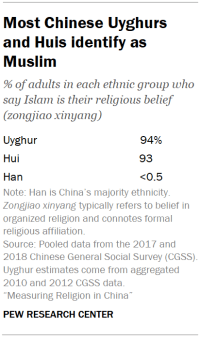
Pew Research Center’s estimate of the number of Chinese Muslims differs from those typically cited by the Chinese government.
China’s 10 traditionally Muslim ethnic groups are among 56 ethnicities measured in the Chinese census. Official estimates of the size of China’s Muslim population – including those generated by the Islamic Association of China, the government agency that oversees Islamic affairs – typically add up the total populations of the traditionally Muslim ethnic groups, assuming that every member of those 10 groups, without exception, is Muslim, and that there are absolutely no Muslims among the Han majority.
By this method of estimation, there were roughly 18 million Muslim adults in China in 2020, accounting for 1.6% of China’s adult population. The two largest of the sub-groups were Hui (8.3 million adults), followed by Uyghurs (7.7 million adults).80
However, there are limitations to using ethnicity as a proxy for Muslim identity.
First, this approach assumes that all members of predominantly Muslim ethnic groups identify as Muslim, which surveys indicate is not the case. For example, 7% of Hui adults do not identify as Muslim, according to data from the 2017 and 2018 CGSS. Likewise, older survey data indicates that about 6% of Uyghurs did not identify as Muslim, as of about 2012.81 (Since then, there has been no survey with a sufficient sample size to analyze Muslim identification among Uyghurs.)
Second, the conventional estimation approach fails to account for Muslim converts of other ethnicities, especially those from the Han majority. Although Han Muslims are rare – only about one in every 1,500 Han adults say their religious belief (zongjiao xinyang 宗教信仰) is Islam, according to surveys – they still could add up to substantial numbers, given that there are 1.02 billion Han adults in China.
To correct for these issues, Pew Research Center demographers estimate that roughly 90% of people in China’s 10 Muslim-majority ethnic groups identify as Muslims and that roughly 700,000 Han Chinese identify with Islam, yielding a total estimate of about 17 million Muslims in China, or around 2% of the adult population. By contrast, the Islamic Association of China’s method – adding up the entire populations of the 10 Muslim-majority ethnic groups and assuming that no one in the Han majority is Muslim – yields an estimate that is higher by nearly 1 million adults.
(Read the Methodology for more details on estimating the number of Muslims in China.)
Demographic traits
Most Uyghur and Hui people belong to the Sunni branch of Islam, but they differ in other ways.
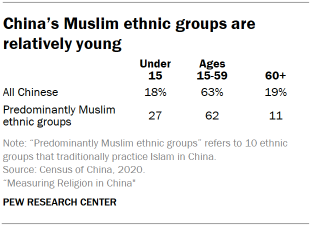
Culturally, Hui people, who began a period of rapid assimilation into the mainstream Han Chinese culture during 14th century, have a good deal in common with the Han majority, including the Han Chinese language and surnames. By contrast, Uyghurs – who until the last century had limited interactions with the Han Chinese – mainly speak Uyghur, a Turkic language. They also differ in appearance and culture from the Han majority.
In addition, Hui and Uyghur people differ on several sociodemographic measures. Uyghurs, on average, are less likely to live in cities and have fewer years of education than the Hui, who are similar to the Han majority on these measures. About 17% of Uyghur people have an urban household registration, or urban hukou (户口), compared with around 40% of Hui and Han people, according to the 2020 Chinese census. Around 5% of Uyghur adults (ages 18 and older) have a college degree or more education, while roughly 10% of Hui and Han adults are college educated.
Fertility
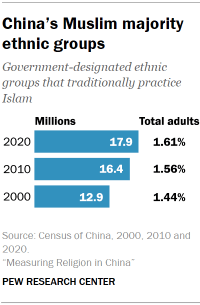
In the past decade, predominantly Muslim ethnic groups have grown more quickly than the majority Han population.
Between the 2010 and 2020 censuses, the number of adults in predominantly Muslim ethnic groups grew by 9% to 17.9 million, while the Han majority grew 5% to 1.02 billion.
This disparity may have resulted, at least in part, from the Chinese government’s less stringent controls on family size for minorities under the one-child policy, which was in effect from 1980 to 2016. While Han Chinese were restricted to having one child per family (or two, if they met certain conditions), ethnic minorities were allowed to have as many as three children per family.
The relatively young age structure of the Muslim population also fuels population growth: 27% of people in China’s predominantly Muslim ethnic minorities are younger than 15, compared with 17% of the ethnic Han majority, according to the 2020 Chinese census.

Also, according to Chinese censuses, the total fertility rate among Uyghur women was 1.84 children per woman in 2010 and 1.99 in 2000, substantially higher than the rate among both Hui women (1.42 in 2010 and 1.53 in 2000) and Han women (1.15 in 2010 and 1.18 in 2000).82 Fertility rates by ethnicity from the 2020 census were not available when this report was written.
In recent years, however, there have been reports of forced birth control methods imposed on Uyghurs and other Muslim ethnic groups in Xinjiang, including mandatory pregnancy checks and sterilizations, as well as coercive IUD implantations and abortions. Scholars expect that Uyghur growth rates will slow as a result of such measures, while the rate among Han Chinese may rise after the Chinese government relaxed restrictions on family sizes, first in 2016 and again in 2021.
Beliefs and practices among Hui Muslims
Since Muslims are a small share of China’s population and surveys often omit regions with large Muslim populations, data on the beliefs and practices of Chinese Muslims is sparse. For example, the CGSS has a sufficient number of respondents to reliably report on the beliefs and practices only of Hui Muslims.83
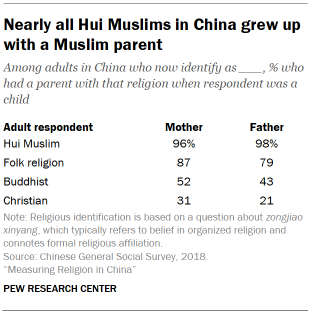
In this section, we analyze 2018 CGSS figures on self-identified Hui Muslims and compare them with Chinese adults who formally identify with folk religion, Buddhism or Christianity. Because this analysis relies on respondents who chose a zongjiao xinyang in the CGSS survey – or who said a parent or spouse has a zongjiao xinyang – it excludes those who may engage with one of these religions but do not formally affiliate with it.
According to this analysis, Hui Muslims are the most likely of China’s major religious groups to grow up with at least one parent who shares their religion.
Among all Hui respondents who claim Islam as their zongjiao xinyang, nearly all (96%) grew up with a Muslim mother, much higher than the rate among adults who identify with Buddhism (52%) and self-identified Christians (31%), according to the 2018 CGSS.
This high level of religious similarity among Muslims also reflects the fact that Islam in China rarely draws converts from other religions. Likewise, the low level of similarity between Christians and their parent(s)’ religion during childhood suggests that most of China’s self-identified Christians come from non-Christian backgrounds.
Survey data indicates that Muslims are also the most likely of China’s major religious groups to marry within their religion. Most Hui Muslim adults (96%) share the same faith as their spouse or cohabitating partner. The comparable figures are substantially lower among adults who identify with folk religion (78%), Buddhism (45%) and Christianity (38%), according to the 2018 CGSS.
Recent change in religious activity
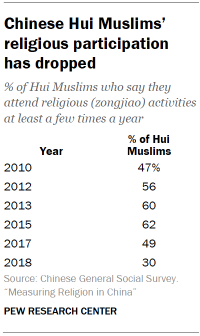
In each of the five CGSS waves between 2010 and 2017, roughly half or more of Muslim respondents (47% to 62%) said they attend zongjiao activities at least a few times a year. In 2018, only 30% said so. This could reflect a change in the way Chinese Muslims answer survey questions in the face of increasingly restrictive government policies, or a change in actual behavior, or some of both.
For comparison, in 2018, 73% of Chinese Christians said they participated in zongjiao activities at least a few times a year, as did 51% of adherents of folk religions and 36% of Buddhists. None of these groups registered a significant decline in self-reported zongjiao participation between 2010 and 2018.
Geographic distribution of Muslims in China
Nearly all of China’s Uyghurs (99%) live in one province, Xinjiang. Hui people are more widely dispersed, with an estimated 10% in Xinjiang and 42% in the other northwestern provinces of Gansu, Ningxia and Qinghai. The remaining half are scattered across the country, with a significant concentration in Henan (8%) and Yunnan (6%).
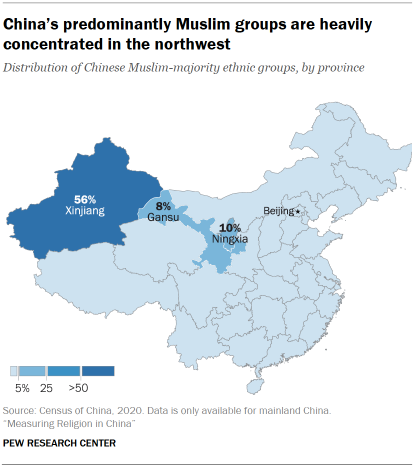
The remaining eight predominantly Muslim ethnic groups, which make up roughly 10% of China’s Muslim-majority groups – Baoan, Dongxiang, Kazakh, Kirgiz, Salar, Tajik, Tatar and Uzbek peoples – mostly reside in the northwestern provinces of Xinjiang, Gansu and Qinghai. There is a particularly heavy concentration of Kazakh, Kirgiz, Tajik, Tatar and Uzbek people in Xinjiang.
As of 2014, Xinjiang was home to 63% of China’s mosques – about 24,500 of a nationwide total of 39,000 mosques, according to data from the Islamic Association of China. About one-quarter of China’s mosques were in other northwestern provinces – Gansu (12%), Ningxia (11%) and Qinghai (3%) – while the remaining 11% of mosques were in other parts of the country.
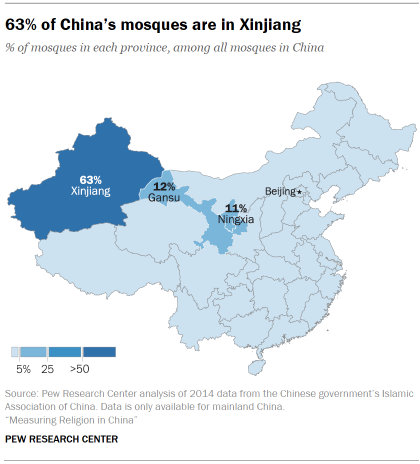
Challenges of studying Islam in China
Studying Muslims in China is difficult for several reasons. The vast majority reside in the northwestern provinces of Xinjiang and Ningxia – mountainous, sparsely populated areas that are often excluded in national surveys for practical reasons. And even when Muslims are surveyed, the samples generally are too small to allow separate analysis and reporting of subgroups, such as by age cohort or gender.
Moreover, the CGSS has not been conducted in Xinjiang since 2013, which leaves no way to assess the current religious beliefs and practices of Uyghur adults in Xinjiang – an estimated 43% of all adults in China’s Muslim-majority ethnic groups.
The Chinese government’s treatment of Muslims adds to the challenges. Muslims who are surveyed may be guarded in their responses, while scholars who study Muslims have faced personal hardship.
For example, IIham Tohti, a Beijing-based economist and Uyghur who criticized Chinese government policies in Xinjiang, was found guilty of “separatism” in 2014 and is serving a life sentence in prison. Rahile Dawut, a professor of Uyghur traditions at Xinjiang University, disappeared ahead of a trip to Beijing in 2017 and has not been heard from since, according to reports in The New York Times and other media.
U.S. scholars have claimed they were banned from traveling to China in connection with their work on Uyghurs. German anthropologist Adrian Zenz, whose online investigations have uncovered extensive visual evidence of conditions in Xinjiang, was sued in 2021 by Chinese companies for his work, which the Chinese Foreign Ministry described as “malicious smearing acts,” The Washington Post reported.
(For more on these topics, read the sidebar called “Human rights abuses in China’s Xinjiang region” and our 2022 analysis of global government restrictions on religion.)
Discussions of Muslims’ views and demographic characteristics in this report are based on the CGSS, which is the only nationally representative survey with sufficient sample sizes to allow such an analysis, though the CGSS has not been conducted in Xinjiang since 2013 and CGSS data collected outside of Xinjiang includes few Uyghur respondents.
The number of Hui Muslims in the CGSS is large enough for analysis, but Hui respondents in the CGSS are so geographically concentrated that their survey estimates have large margins of sampling error on some measures. For instance, the share of Hui Muslim adults who attend religious activities once a week or more (11%) in the 2018 CGSS has a margin of error of plus or minus 8 percentage points, compared with 6 points for Christians and 2 points for Buddhists.
Sampling coverage issues in the CGSS also pose challenges to estimating the number of Muslims in China. Overall, predominantly Muslim ethnic minorities, particularly Huis, are oversampled in the CGSS even though some regions with large minority populations have been omitted in recent waves. The CGSS includes a larger share of Muslim ethnic minorities than China’s census and the default CGSS weight does not correct for this imbalance. To address this issue, Center researchers adjusted the weight in the CGSS so that the share of adults in predominantly Muslim ethnic groups matches the share of those ethnic groups in the census. (Read the Methodology for more on how we estimate the number of Muslims in China.)
Sidebar: Human rights abuses in China’s Xinjiang region
The Chinese government’s actions against Uyghur Muslims in the northwestern region of Xinjiang have drawn international attention and censure in recent years.
Human rights groups have accused China of subjecting hundreds of thousands of Muslims to mass internment, surveillance and torture. There have been reports of forced abortions and sterilizations, forced organ harvesting, forced relocation and labor, and forced separation of children. Amnesty International has said that China’s “draconian repression of Muslims in Xinjiang amounts to crimes against humanity,” and the U.S. State Department has described China’s treatment of Uyghurs as genocide. In 2022, the UN High Commissioner of Human Rights issued a report saying that “serious human rights violations have been committed” in Xinjiang and that “the extent of arbitrary and discriminatory detention of members of Uyghur and other predominantly Muslim groups … may constitute international crimes, in particular crimes against humanity.”
The Chinese government has denied these allegations. In July 2022, China reportedly tried to stop the release of a UN report detailing abuses against Muslims. Chinese officials have said camps in Xinjiang are for vocational education and training and are meant to counter religious extremism and poverty in the region.
Accusations of repression of Uyghurs and other Muslims by the Chinese government date back many years. In 2005, Human Rights Watch described the “systematic repression of religion … in Xinjiang as a matter of considered state policy,” at a “level of punitive control seemingly designed to entirely refashion Uighur religious identity to the state’s purposes.”
However, human rights groups say the crackdown intensified after the 2009 riots in Urumqi, the capital of the Xinjiang Uyghur Autonomous Region, which left nearly 200 people dead. The Chinese government labeled the riots as terrorism arising from Islamic extremism and expanded regulation and surveillance in the name of de-extremization.
Many religious practices among Uyghurs and other Muslim-majority ethnic groups in Xinjiang that previously were respected as ethnic customs now face tight regulation. For instance, the government has banned face coverings in public; made it illegal for parents to let children attend religious activities or religious schools; cracked down on “underground” Muslim schools and study groups; and increased penalties on Muslims who follow traditional Islamic marriage and divorce laws. The Chinese government also has intensified the enforcement of restrictions on the number of children allowed for Uyghur Muslims and severely punished those who exceed the limit.
For decades in the 1970s, ’80s, ’90s and 2000s, the government imposed a “one-child policy” that limited births among Han Chinese, a policy that was often realized with forced contraceptives, sterilization and abortions. During this period, urban Uyghur couples were allowed to have two children and rural Uyghur couples could have three children. In 2016, the Chinese government relaxed the one-child cap for most of the population while enforcing birth controls for minorities. In 2021, the policy was again adjusted to allow up to three children per couple, but with no exceptions for ethnic minorities.
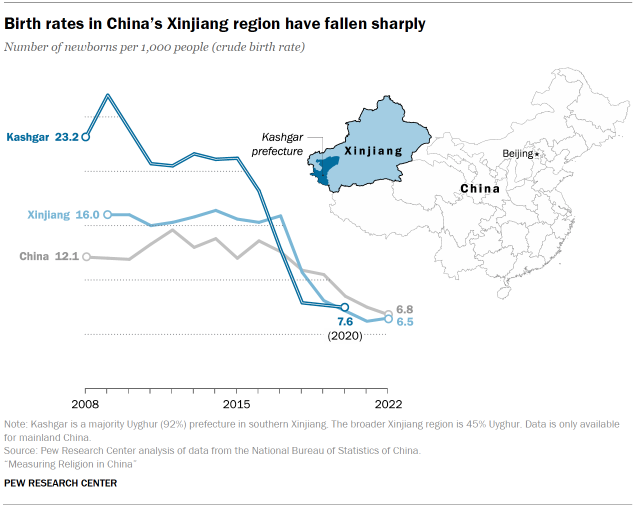
Xinjiang’s birthrate has fallen significantly in recent years: In 2019, the region’s crude birth rate – the number of births per 1,000 people – hovered below the national average (10.5) for the first time, at 8.1, nearly half the rate three years earlier, according to the National Bureau of Statistics of China.
The decline in the birth rate is particularly pronounced in southern Xinjiang, which has a heavier concentration of ethnic minorities. For instance, between 2016 and 2018, the crude birth rate in Kashgar, a 92% Uyghur prefecture, dropped in half from 18.2 births to 7.9 per 1,000 people. These large changes in fertility patterns coincide with government interventions, which may have been designed to reduce growth in ethnically Muslim populations in Xinjiang.
Moreover, the strict prohibition on providing formal religious education to children may disrupt the intergenerational transmission of religious beliefs and practices among Muslim-majority ethnic minorities in Xinjiang and other parts of China.
6. Non-religion
Children make vows during a ceremony for newly joined members of the Young Pioneer Organization, a youth branch of the Chinese Communist Party, in Fuyang, China, in 2019. (Visual China Group via Getty Images)
Many international studies, including from Pew Research Center, compare levels of religious identity and commitment across countries. China tends to rank high on the lists of countries with the biggest share of people who are – by several measures – secular.
In China, religious affiliation is typically translated as “religious belief,” such as in the Chinese General Social Survey (CGSS) question “What is your religious belief (zongjiao xinyang 宗教信仰)?” In 2018, 90% of Chinese adults chose the option “No religious belief” in response to this question.84 By this measure, about 998 million Chinese adults were religiously unaffiliated in 2018. Other national studies, including the World Values Survey (WVS), also find that about nine-in-ten adults in China do not have a zongjiao xinyang.
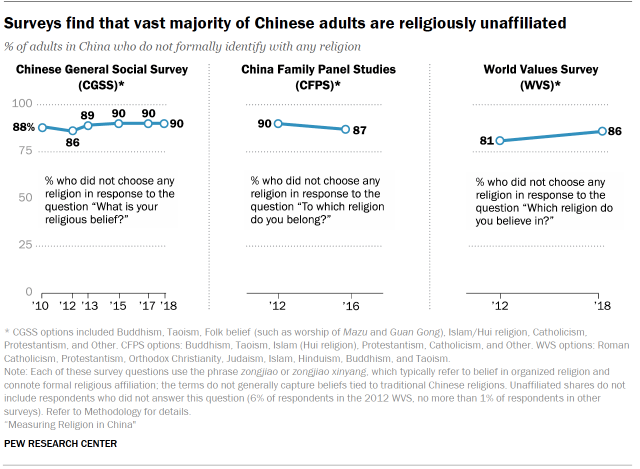
However, questions that translate religion as zongjiao (宗教) capture a narrow facet of religion, as the phrase commonly connotes formal membership in a religious organization or a public commitment to a religious belief system. When respondents choose the “no religious belief” (wu zongjiao xinyang 无宗教信仰) option in a survey, they might not have in mind a complete lack of religious or spiritual beliefs. For example, they may not associate belief in Buddha and/or a bodhisattva or folk deities with the word “religion” (zongjiao).
In addition, some Chinese people may reject zongjiao affiliation because they only occasionally engage in zongjiao activities, or because they see that the state disapproves of zongjiao.
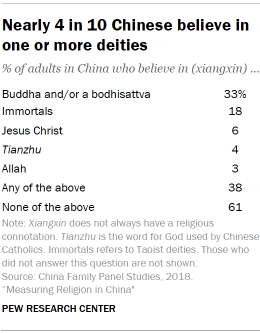
As a result, the share of people who claim to have “no religion” is far larger than the share who reject any belief in gods or who never engage in spiritual activities. For example, when asked whether they believe in (xiangxin 相信) any gods or deities, only 61% of Chinese adults said they do not believe in Buddha and/or a bodhisattva, Taoist immortals, Jesus Christ, Tianzhu (天主, the word for God used by Chinese Catholics), or Allah, according to the 2018 CFPS. (Xiangxin, which is commonly translated as “believe in,” also means to trust or have no doubts in. The term does not always connote worship or veneration.) When the analysis includes belief in supernatural forces or participation in traditional customs with spiritual underpinnings, the rate of non-religion drops even further.
And while the Chinese Communist Party espouses atheism as its official ideology, just one-third of Chinese adults identify as atheist (wu shen lun zhe 无神论者), according to the 2018 WVS.
This chapter discusses different ways of looking at non-religion in China, and it explains the advantages and limitations of using zongjiao affiliation to estimate the extent of secularism in China.
While it is an exaggeration to say that 90% of China’s population is secular, it also is an exaggeration to suggest that religious and/or spiritual practices are pervasive and frequent. Common survey measures and categories of analysis tend to ignore traditional customs and may poorly capture beliefs, which overlap and are not consistently detected when question wording and format vary. Ultimately, the best available survey data indicates that in many senses, a considerable portion of China’s population rejects supernatural beliefs and does not engage in frequent religious rituals.
Characteristics of those with no zongjiao affiliation

Religious non-affiliation is particularly high among members of the Chinese Communist Party (CCP): 94% of this group is religiously unaffiliated, according to the 2018 CGSS. This is likely due at least in part to the Chinese government’s ban on zongjiao affiliation for its members and cadres. Religious non-affiliation is also high among Chinese adults with a college degree or more (94%). This similarity may be due to the correlation between education and CCP membership: CCP members are more likely than other Chinese to have a college degree, and nearly half of college-educated adults are members of the CCP or its Youth League, the survey shows. Refer to the sidebar called “The Chinese Communist Party’s role in China’s low levels of zongjiao religion.”
Chinese from the Han majority (92%) are more likely than people from ethnic minorities (71%) to be religiously unaffiliated, according to the 2018 CGSS.
On the other hand, older adults (ages 55 and older), women, and people living in rural areas are less likely to be religiously unaffiliated (88% each).
Not surprisingly, lack of zongjiao affiliation correlates with low rates of zongjiao engagement: Around 2% of unaffiliated adults participate in zongjiao religious activities at least a few times a year, compared with 45% of affiliated adults, according to the 2018 CGSS.
People without a zongjiao affiliation also are far less likely than affiliated adults to say zongjiao is very important in their lives (1% vs. 18%), according to the 2018 WVS.
Engagement with traditional beliefs and practices
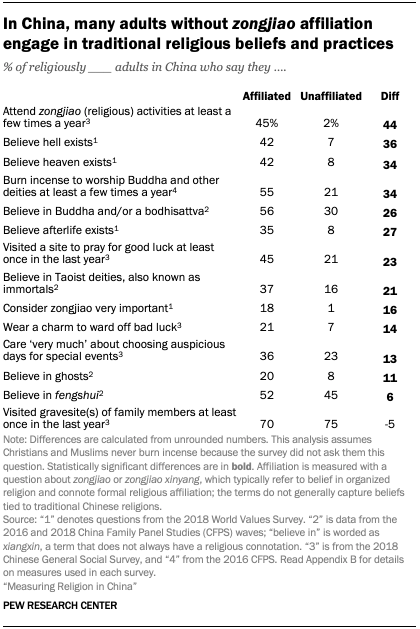
Nevertheless, Chinese adults without a zongjiao xinyang still engage in beliefs and practices associated with traditional Chinese religions, though often to a lesser extent than religiously affiliated adults.
Religiously unaffiliated and affiliated adults are about as likely to perform the Confucian ritual of ancestor worship, with 75% of religiously unaffiliated adults and 70% of affiliated adults saying they visited the gravesite(s) of family members at least once in the past year, according to the 2018 CGSS.
Fully 61% of religiously unaffiliated adults say they care “somewhat” or “very much” about choosing an auspicious day for special occasions, such as weddings and funerals, compared with 66% among religiously affiliated adults, the same survey shows. And 45% of unaffiliated adults say they believe in fengshui (风水), compared with 52% of affiliated adults who say this, according to the 2016 and 2018 CFPS waves.
Differences between religiously unaffiliated and affiliated adults are larger on other measures. Unaffiliated adults are far less likely to say they burn incense to pay respects to Buddha or other deities at least a few times a year (21% vs. 55%) and even less likely to do so monthly or more often (8% vs. 34%), according to the 2016 CFPS.
Unaffiliated adults are less likely than affiliated adults to say they believe in Buddha (30% vs. 56%) and Taoist deities (16% vs. 37%), according to the 2016 and 2018 CFPS waves.87
They are also less likely to say they visited a site to pray for good luck in the last year (21% vs. 45%), according to the 2018 CGSS.
Atheism among Chinese adults
Considering the Chinese government’s active promotion of atheism and communism in schools and state-run media, one might expect most Chinese adults to identify as atheist, a politically desirable label.
However, only about a third of adults in China (34%) say they are atheist, when asked to choose from three options in the 2018 WVS – a religious person(or a person with zongjiao xinyang), not a religious person, or an atheist (wu shen lun zhe 无神论者) – to identify themselves.88 Roughly half (49%) say they are not a religious person, while 16% say they are a religious person.
In the Chinese translation, “religious person” means a person of zongjiao xinyang. A different wording or question format might produce higher or lower estimates. For instance, it is possible that a much higher share of Chinese adults would answer “an atheist” if forced to choose between “an atheist” and “not an atheist,” as the latter may indicate that one has a zongjiao belief, which is politically undesirable.

College-educated adults are more likely to say they are atheist than those without a college degree (44% vs. 32%). The correlation between education and atheist identity is likely tied to CCP membership patterns. Roughly half of college-educated adults are members of either the CCP or its Youth League, according to the 2018 CGSS. (Refer to the discussion of the CCP’s role in promoting non-affiliation.)
Sidebar: The Chinese Communist Party’s role in China’s low levels of zongjiao religion
In line with the Marxist view that religion is a temporary phenomenon that will fade as societies advance, the ruling Chinese Communist Party (CCP) espouses and promotes atheism, thus stigmatizing belief in and engagement with religion, including zongjiao (宗教) and “superstition” (mixin 迷信). Children under 18 are constitutionally prohibited from having any religious belief (zongjiao xinyang 宗教信仰), and atheist education begins early.
The CCP has more than 97 million adult members. An additional 30 million people are actively seeking affiliation with the CCP, including 21 million whose applications are awaiting review and 10 million who are in the advanced stages of becoming members. To join CCP-affiliated organizations, one must declare a commitment to communism, which requires renouncing any zongjiao xinyang, or formal religious affiliation. In addition, almost every primary school student pledges commitment to the communist cause in order to join the CCP’s Young Pioneers, which is considered a great honor, and large numbers of advanced students are recruited for the Youth League in middle and high school. Overall, 184 million people belong to the CCP’s Young Pioneers and Youth League.
This means that about one-fifth of China’s population has an active membership of some kind with the CCP or its youth affiliates.
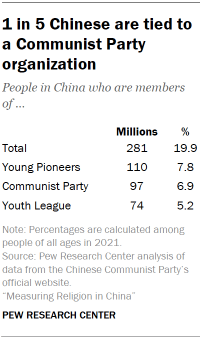
The CCP bans its members and government officials, including those who are retired, from having zongjiao xinyang. In state-run media, holding zongjiao xinyang is equated with wavering loyalty to the CCP and a betrayal of communism. In speeches, President Xi Jinping and other officials stress that CCP members must be “unyielding Marxist atheists.”
CCP membership brings career opportunities and benefits, while zongjiao xinyang may invite scrutiny and even disadvantage. The popular national civil service exam, where applicants compete for “golden rice bowl” positions, is an example. Even though applicants, regardless of political or religious background, are in theory guaranteed equal treatment, CCP members are known to have better chances of securing a position than non-members. By contrast, eligible candidates who have participated in superstitious or zongjiao activities risk failing the political background check.
There are also reported instances of Chinese people losing jobs due to their zongjiao xinyang, and of college students being pressured to renounce their faith. The prospect of such complications may discourage people from participating in zongjiao activities or disclosing their zongjiao xinyang, if they have any, on surveys.
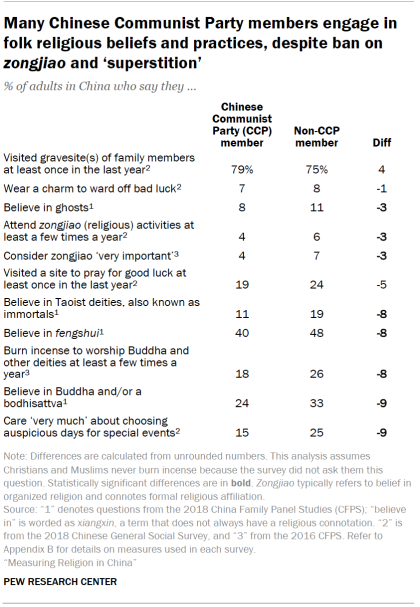
While the CCP imposes a strict ban on zongjiao activities among officials and CCP members, it tolerates occasional or infrequent engagement in some traditional Chinese religious practices. For example, visiting temples occasionally is not an indicator of involvement in zongjiao or “superstitious” (mixin) activities, according to the CCP’s instructions. CCP members are also allowed to participate in folk activities with religious elements.
However, any CCP members who actively practice superstition – such as carrying many amulets and frequently consulting fortunetellers – face expulsion.
Likewise, while the CCP’s campaigns in favor of atheism may have been effective in discouraging people from engaging in zongjiao or superstitious beliefs and practices, they have not been completely successful.
In fact, a considerable share of CCP members express beliefs in fengshui (40%), Buddha and/or a bodhisattva (24%), and Taoist immortals (11%), though those rates are lower than among non-CCP members, according to the 2018 CGSS and other surveys.
Moreover, CCP members are no different from the rest of the adult population in their propensity to engage in customary activities that may not be overtly zongjiao or “superstitious,” such as carrying a lucky charm or amulet, visiting a religious site to pray for good fortune, or visiting the gravesite(s) of family members.
Government policy toward religion in the People’s Republic of China – a brief history
The Chinese Communist Party (CCP) is officially atheist, and its members are not permitted to join any religion. The party’s attitude aligns with the Marxist view that religion is a temporary historical phenomenon that will disappear as societies advance. Although this stance has not changed in the seven decades since the state’s founding, policies on the ground have constantly evolved. For example, the current constitution of the People’s Republic of China, adopted in 1982, states that ordinary Chinese citizens enjoy “freedom of religious beliefs” (zongjiao xinyang ziyou 宗教信仰自由).
After then-Chairman Mao Zedong’s CCP established the People’s Republic of China in 1949, religion – “the opiate of the masses,” according to Karl Marx – quickly became a target.
Political leaders at the time described religion as being linked to “foreign cultural imperialism,” “feudalism” and “superstition.” Religious groups were persecuted across the board: Buddhist monks for participating in a feudal regime that supported them with donations, and Christians for their ties to foreign missionaries and the Vatican.89
In the 1950s, as a part of a nationalization campaign, the government confiscated many temples, churches and mosques for secular use.90 Foreign missionaries were deported, and churches were urged to cut ties with outside organizations, including the Vatican.91
Meanwhile, the government established a Religious Affairs Bureau to oversee religious activities and promoted the Three-Self Patriotic Movement (self-government, self-support and self-propagation) for religious groups. By the late 1950s, patriotic religious associations had been formed to manage and monitor each of five religions – Buddhism (1953), Islam (1953), Protestantism (1954), Taoism (1957) and Catholicism (1957).
1966-1976: Mao Zedong’s Cultural Revolution
Tibetan students in Beijing learn about Mao Zedong’s anti-Confucian campaign in April 1974. (Gamma-Rapho/API via Getty Images)
During the Cultural Revolution, religion became a target of Mao’s campaign to eliminate the “Four Olds” – “old things, old ideas, old customs and old habits.” All religious activities were banned, and religious personnel were persecuted. Paramilitary Red Guards attacked or destroyed many temples, shrines, churches and mosques, and some were abandoned, closed or confiscated.92 Chinese people who wanted to maintain their faith practiced in secret.
1982: Document 19
Tibetan Buddhists walk the kora – repeatedly walking and meditating around a sacred site or temple – in 2021 in front of the Jokhang Temple, Tibet’s holiest site, which was attacked by Red Guards during the Cultural Revolution. (Kevin Frayer/Getty Images)
State policy toward religion shifted after Mao’s death in 1976. In 1982, the Central Committee of the CCP issued a manifesto that came to be known as Document 19, in which the CCP acknowledged the complexity associated with religion and granted its citizens freedom of religious belief (zongjiao xinyang ziyou).
The document also set boundaries for religious freedom by allowing only “normal” religious activities (though it left “normal” undefined) and banning religious education among minors. In addition, the CCP banned party members from practicing or believing in religion and stressed the importance of strengthening atheist education among China’s citizens.
In the decades following the Cultural Revolution, the government focused on economic development. Religious activity began to revive. Temples, mosques and churches closed or confiscated during the Cultural Revolution were allowed to reopen, while those that had been damaged or destroyed were repaired or rebuilt – some with government funds. Buddhist temple construction and activities significantly benefited, as authorities hoped religious tourism would boost the economy.93
Government officials in some instances even tolerated religious groups or activities outside the legally sanctioned system. For instance, the popular pastor Samuel Lamb (Lin Xiangao), who led a large underground Protestant church in Guangdong province, was generally left to operate freely in the 1980s.
In this relaxed climate for religion, the traditional practice of Qigong (气功) became widespread, by some estimates attracting more than 60 million practitioners across China by the late 1980s. Qigong – a set of exercises and meditative practices related to Buddhism and Taoism – was openly endorsed for its purported health benefits and promoted by high-level officials and leading scientists. Despite its spiritual roots, authorities did not view Qigong as superstition or even religion, instead declaring it a “precious scientific heritage.”94 During this time, many new Qigong masters, who claimed to have supernatural power (teyi gongneng 特异功能), emerged. So did new forms of Qigong that incorporated elements of folk, Taoist and Buddhist traditions.
1989: Tiananmen Square protests
Student protesters gather in May 1989 in Tiananmen Square, Beijing, to demand greater freedom of speech and democracy. On June 4, the government shut down the protests in what came to be known as the Tiananmen Square Massacre. (Peter Turnley/Getty Images)
The student-led, pro-democracy protests in Tiananmen Square, Beijing, that were ended violently by the government led to tighter regulation in all spheres of life.95 Authorities cracked down on religious groups outside the official system and arrested their leaders and members, significantly affecting underground churches.
In 1995, China’s leadership labeled 15 religious groups, including 12 with Christian roots, as “evil cults” and banned them. Soon after, it also outlawed some Qigong groups.96
Falun Gong (法轮功), a spiritual group that emerged in the early 1990s, was officially denounced as an “evil cult” in 1999, following the Zhongnanhai Incident, when thousands of Falun Gong practitioners protested outside the leadership compound of the CCP central committee, demanding official recognition. At the time, Falun Gong claimed to have 70 million adherents in China.
People participate in a Falun Gong (法轮功) morning exercise and mediation group on July 22, 1999, in Guangzhou, China, just hours before the group was declared an illegal organization (or “evil cult”) by the Chinese government. (AFP via Getty Images)
Since then, Falun Gong has been treated harshly. The government established the Office for Preventing and Dealing with the Evil Cult Issue, also known as the 610 Office, to crack down on Falun Gong nationwide.
2004: ‘Regulations on Religious Affairs’
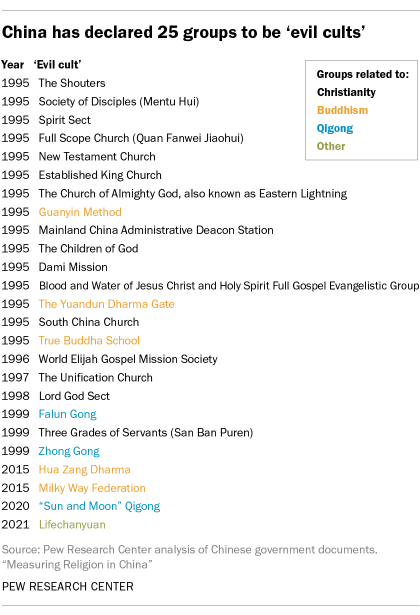
While the government cracked down on these new religious groups, the state policy on five recognized religions shifted slightly, becoming relatively lenient as political leaders emphasized pushing them to adapt to the socialist society. In 2004, the State Council issued a set of “Regulations on Religious Affairs.”
The document listed rules for religious personnel, sites and activities. It specified that local religious bureaus could exercise legal and administrative authority over religious affairs, such as closing unregistered churches and confiscating properties.
However, the regulations were not always strictly enforced at the local level. Observers say that local authorities managed religious practices with “one eye open and one eye closed” and tolerated “illegal” religious activities as long as “no lines have been crossed.”97
In other words, local regulations on religious activities under then-President Hu Jintao’s leadership (2003-2013) remained essentially unchanged from the previous decade, as Hu believed religion could contribute to a harmonious society.98
2015: Xi Jinping’s ‘Sinicization campaign’
Children attend a Holy Communion during Christmas Mass at a Catholic church in Beijing in 2009. Since 2017, the Chinese government has tightened control over religion and strictly enforced the ban on children attending religious services. (Liu Jin/AFP via Getty Images)
Since Xi Jinping came to power as the general secretary of the CCP in 2012 and officially took office as China’s president in 2013, he has followed a new strategy on religion.
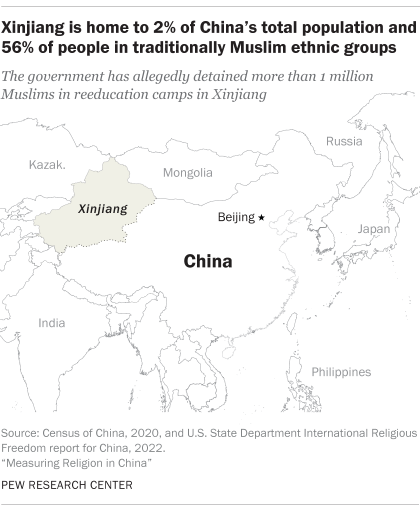
Xi summarized his approach to religious groups in a speech in 2015 that called for the “Sinicization of religions,” urging all religious groups in China to adapt to socialism by integrating their doctrines, customs and morality with Chinese culture. The campaign particularly affects so-called “foreign” religions. Leaders of Protestantism, Catholicism and Islam are expected to align their teachings and customs with Chinese traditions and “pledge loyalty” to the state.
His strategy is two-pronged: On the one hand, the government has tightened controls on Islam and Christianity. China’s policy toward Muslims includes the detention of Uyghurs in Xinjiang and a crackdown on underground Quran study groups.
Toward Protestants, the government has reinforced its ban on unauthorized worship sites, forcing house churches to join a state-run association and detaining religious leaders who refuse to cooperate.
Similarly, “underground” Catholics have faced increased harassment, especially after the Beijing-Vatican deal in 2018, which paved the way for the Chinese government and the Holy See to cooperate in appointing bishops.
On the other hand, as Xi has promoted traditional Chinese culture, activities tied to Confucianism, Taoism and Buddhism have continued to experience relative leniency.
For instance, the government has allocated funds to protect and repair cultural relics, including Buddhist grottoes, and has encouraged Taoists to contribute to constructing an “ecological civilization.”
This is not to say that Confucianism, Taoism and Buddhism have been spared from government control.
These groups, too, have faced increased scrutiny, though to a lesser extent than Islam and Christianity. For example, the government has enacted measures to tackle “outstanding problems” in the Buddhist and Taoist communities, including alleged commercialization, misconduct by Buddhist leaders, and fake monks.
People dressed as ancient scholars attend a memorial ceremony to mark the 2,571st anniversary of Confucius’ birthday at the Confucius Temple in Nanjing, China, on Sept. 28, 2020. (Liu Jianhua/VCG via Getty Images)
The State Council updated its “Regulations on Religious Affairs” in 2017. Since then, local authorities have intensified efforts to investigate, register and manage unauthorized places of assembly, such as house churches.
In 2018, the State Administration for Religious Affairs (SARA), which previously enforced religious policy relatively independently, was renamed the National Religious Affairs Administration and placed under the direct supervision of the United Front Work Department (UFWD) – a powerful agency responsible for neutralizing or stifling potential opposition groups that is sometimes referred to as the CCP’s “magic weapon” – signaling a tightening of the party’s grip on religion. SARA’s local offices were subsequently absorbed into the UFWD.
In 2021, the government issued a new regulation on online religious content, banning unauthorized religious activities and unregistered religious groups from sharing religious content online.
Acknowledgments
This report was produced by Pew Research Center as part of the Pew-Templeton Global Religious Futures project, which analyzes religious change and its impact on societies around the world. Funding for the Global Religious Futures project comes from The Pew Charitable Trusts and the John Templeton Foundation (grant 61640).
This report is a collaborative effort by Pew Research Center staff. Find related reports online at pewresearch.org/religion.
This report benefitted from the feedback of six eminent scholars, who have asked to remain anonymous. While the analysis for this report was guided by our consultations with these advisers, the Center is solely responsible for the interpretation and reporting of the data.
Methodology
This report relies primarily on data from seven waves of the Chinese General Social Survey (between 2010-21) and four waves of data from the China Family Panel Studies (between 2012-18) to discuss China’s religious landscape and how it has changed in recent years. Additionally, some analysis uses the China Labor-force Dynamics Survey (between 2012-14), World Values Survey (between 2007-18) and Spiritual Life Study of Chinese Residents (2007).
This Methodology section first describes each of these surveys. Subsequently, it describes how Pew Research Center researchers used these and other sources, including government statistics, to analyze the size of religious groups in China.
Surveys
Chinese General Social Survey (CGSS)
The CGSS is a large-scale cross-sectional survey of Chinese households launched in 2003. Since 2010, it has been conducted by the National Survey Research Center at Renmin University of China. This report relies heavily on six publicly available waves undertaken in 2010, 2012, 2013, 2015, 2017 and 2018. Each wave includes about 12,000 respondents, sampled across at least 28 of mainland China’s 31 provinces, municipalities and autonomous regions, with Hainan, Tibet and Xinjiang excluded from nearly all waves. The 2018 wave included religion modules with additional religion measures. This report also presents results from the two religion questions included in the 2021 wave of about 8,000 respondents, sampled across 19 provinces, municipalities and autonomous regions during the COVID-19 pandemic. The CGSS is funded by Renmin University and, via Project 985, the Chinese government.
(Read “How the 2021 CGSS compares with surveys in previous years” for more information.)
The CGSS consistently includes questions on religious identity and participation, which makes it useful for analyzing religious affiliation trends among Chinese adults. The CGSS question asks about religious belief (zongjiao xinyang) – language that implies a formal commitment to an organized religion or value system. The CGSS is the only survey that lists “folk religion (such as worship of Mazu and Guan Gong)”as a response option. Separately, its 2018 survey asks one third of the respondents (around 4,500 adults) about beliefs and practices commonly associated with folk religions, including frequency of visits to the gravesite(s) of deceased family members. (For more details, read Appendix B.)
Compared with other surveys, the CGSS has a wider sampling coverage.99 The CGSS covers more of China’s regions than many other surveys. The 2010 wave of the CGSS had the most extensive coverage, with respondents from all 31 provincial units in mainland China. After 2013, the CGSS did not include respondents in Xinjiang, where virtually all Uyghurs reside. The Uyghur and Hui ethnic groups make up the vast majority of China’s Muslim population. Recent waves of the CGSS underrepresent Uyghurs due to the omission of Xinjiang. However, the Hui are overrepresented in the CGSS when the standard weight is used. The CGSS includes some primary sampling units that are predominantly Hui communities, such as Tongxin, a county in Ningxia that is about 85% Hui. While Hui adults are about 0.7% of the Chinese adult population, they make up 2%-3% of respondents in most CGSS waves.
All CGSS datasets used in this report have been reweighted so that the combined weighted share of ethnic minority respondents, including these Muslim majority ethnic groups, matches the aggregate adult share of these ethnic groups in China’s census. (For more details, read the section on estimating Islam in China later in this Methodology).
China Family Panel Studies (CFPS)
The CFPS is a longitudinal survey of communities, families and individuals run by Peking University’s Institute of Social Science Survey. It has included religion measures since 2012. The CFPS takes place every two years and re-interviews respondents who participated in the baseline survey. This report draws on data from four waves: 2012, 2014, 2016 and 2018. When this report was written, the 2018 CFPS was the most current dataset with religion information available to Pew Research Center.100 Each wave includes about 35,000 adults in more than 13,000 households. The CFPS is funded by Peking University and the government-supervised Natural Science Foundation of China.
Although the CFPS interviews mostly the same respondents over time, different religion measures are used across waves, which makes it challenging to measure religious change. For instance, the 2012 survey measures religious affiliation, while the 2014 survey asks about belief in (xin) gods/deities. When similar questions are asked in multiple waves, differences in wording and response categories make it hard to determine the extent to which apparent differences represent real change. Most interviews were conducted face-to-face. The share of interviews conducted over the phone made up 5% or less in the earlier waves, while about 17% of interviews in each of the 2016 and 2018 surveys were conducted by phone.101
In addition, the CFPS survey has a higher rate of missing religion variables than other surveys. For instance, religious affiliation is missing for about 10% of respondents in the 2016 CFPS survey, while nonresponse on the religion variable is typically less than 0.1% in the CGSS. The CFPS’s higher proportion of missing data is primarily the result of survey design: The survey allows family members to answer nonattitudinal questions when the respondents are not present in the household at the time of the interview.102
The CFPS includes measures of religious beliefs, practices and the importance of religion (zongjiao). The most recent wave, conducted in 2018, collected information on belief in various deities – Buddha and/or a bodhisattva, Taoist deities, Allah, Jesus Christ, Tianzhu (the word Chinese Catholics use for God) – and other supernatural concepts, such as fengshui and ghosts.
The 2016 survey asked about respondents’ engagement in specific religious activities such as burning incense or venerating Buddha/deities (shaoxiangbaifo) and attending worship services (zuo libai). The survey assumed that Buddhists and Taoists do not attend worship services and that Christians and Muslims do not burn incense to worship Buddha. Therefore, the question about burning incense was not asked of Muslim and Christian respondents, and the question about attending worship services was skipped for Buddhists and Taoists. (For more details, read Appendix B.)
China Labor-force Dynamics Survey (CLDS)
The CLDS is a survey project run by the Center for Social Science Survey at Sun Yat-sen University. The CLDS collects data on communities, households and working-age individuals (ages 15 to 64). This report uses data from the 2012 wave, which had more than 15,000 adult respondents, and the 2014 wave, which had more than 21,000 adult respondents. When the report was written, the 2014 CLDS was the most recent dataset available to Pew Research Center. The CLDS is funded by the Guangdong government and China’s central government via Project 985. The CLDS collected information on religious affiliation between 2012 and 2018, so this survey can be used to assess religious change among the adult population under age 65 during this period.
However, Pew Research Center did not receive approval to access 2016 and 2018 data due to the CLDS’s data sharing policy, which restricts access to university staff/students or independent researchers in China only.
The CLDS data also includes religious site information at the neighborhood committee level. Neighborhood committees – known as villagers’ committees (cunweihui) in rural areas and as residents’ committees (juweihui) in cities – are the smallest administrative unit in China.103 The survey covers between 300 and 400 neighborhood committees in each wave and asks an informed staff member on the committee about whether there are any Buddhist temples, Taoist temples, folk religion shrines, churches, ancestral halls, and mosques in the committee’s jurisdiction. (For more details, read Appendix B.)
World Values Survey (WVS)
The WVS is a research program headquartered in Stockholm, Sweden. It’s run by an international network of survey researchers. The most recent wave of the China survey (2018) was conducted by the Center of Survey and Public Research at Shanghai Jiao Tong University. Data in this report is from three waves. The 2007 and 2012 waves had about 2,000 respondents each. The 2018 wave had 3,036 respondents and was funded by Shanghai Jiao Tong University, Shandong University, Peking University and Tsinghua University. The 2018 survey consists of respondents from 29 provincial units (Tibet and Xinjiang are excluded).
The WVS survey, despite its relatively small sample size, provides a unique perspective on religious trends in China because it includes questions not asked in other surveys. Besides collecting information on religious affiliation and participation, the survey includes measures of the importance of religion, including the importance of teaching religious faith to children, and a measure of atheist identification. The 2012 and 2018 waves measure belief in life after death, belief in hell, and belief in heaven. (For more details, read Appendix B.)
Spiritual Life Study of Chinese Residents (SLSCR)
The SLSCR is a nationally representative survey conducted in 2007 by the Chinese polling firm Horizon Research Consultancy Group. The survey follows a multi-stage sampling design and consists of 6,861 adults interviewed in 24 provinces in China (excluding Hainan, Jilin, Ningxia, Qinghai, Tianjin, Tibet and Xinjiang).
The SLSCR includes detailed questions on religious beliefs and practices, including those relating to Chinese folk religion. The survey includes a wide range of religion measures, such as the practice of burning incense to pay respects to deities at home or in a temple, attending worship services in church, and beliefs in various supernatural beings, including Buddha, Jesus Christ, deities and ghosts.
Several measures of religious beliefs and practices in the SLSCR are similar to measures in the CFPS, but differences in question wording often make it difficult to infer trends by comparing the two surveys. For example, the SLSCR asked respondents about believing in (xiangxin) Buddhismor believing in (xin) Buddha, while the CFPS measured belief in (xin) Buddha and/or a bodhisattva. The former captures respondents who either identify with Buddhism or believe in Buddha, while the latter measures belief in Buddha and/or a bodhisattva. (For more details, read Appendix B.)
How the 2021 CGSS compares with surveys in previous years

The most recent Chinese General Social Survey (CGSS) was conducted roughly between June and September 2021, during the COVID-19 pandemic. This period encompassed the initial surge of the highly transmissible and aggressive delta variant. Under China’s “zero-COVID” policy, neighborhoods and sometimes entire cities imposed strict lockdowns – including limits on movement outside of homes and closing of public venues – when new local infections were recorded. For instance, neighborhoods in several cities of Guangdong province were in lockdown in June 2021 due to the spread of the delta variant, and by August, the variant had caused lockdowns in more than a dozen provinces in China.
Although pandemic constraints may have affected the implementation of the survey across China, it appears the CGSS team did not revise their sampling strategy, according to their description of the 2021 wave. Following the same sampling plan as in previous years, they selected 125 primary sampling units (PSU) from the national total of 2,762 county-level units, with China’s five metropolitan cities (Shanghai, Beijing, Shenzhen, Chongqing, and Tianjin) each set as a separate self-representative stratum.104
However, the CGSS team ended up collecting data in fewer provinces, municipalities and autonomous regions (19) in the 2021 wave than in previous years (28-31). In 2018, data was collected in 28 provinces. Pew Research Center emailed the CGSS team to ask for an explanation, but we did not receive a reply. The reason may be that data collection was difficult or impossible in some provinces, such as Guangdong, Shanghai and Yunnan, during the delta variant outbreaks.
Data collected in the 2021 wave covered provinces where 70% of China’s population resides – as opposed to more than 99% in previous years. Excluding those provinces does not seem to affect demographic measures including age, sex, urbanicity and education, which are corrected by the survey weight. However, the survey weight does not adjust for religious affiliation.
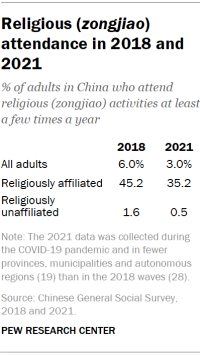
The 2021 estimates of religious affiliation differ from previous waves. For example, in the 2021 CGSS, 0.2% of Chinese adults identify with folk religion (responding that they venerate “Mazu, Guan Gong, etc.”), compared with 2.7% in 2018. Meanwhile, the share of Chinese who say they have no religious belief (zongjiao xinyang) was 3 percentage points higher in 2021 than in 2018 (93% vs. 90%).
A closer look at the data suggests the nine provinces that were missing from the 2021 wave compared with the 2018 wave – Guangdong, Guizhou, Heilongjiang, Jilin, Qinghai, Shanghai, Sichuan, Tianjin and Yunnan – together have a higher share of folk religion adherents than the rest (6% vs. 1%).
Due to these limitations of the 2021 CGSS, the discussion of religious affiliation in this report is primarily based on data collected from 2010 until 2018.
In addition, since the 2021 survey was conducted during a period of severe restrictions on travel and indoor gatherings, we did not use the latest wave to explore the trend of religious (zongjiao) participation either. The 2021 CGSS shows that about 3% of Chinese adults reported attending zongjiao activities at least a few times a year, down from 6% in 2018.105 This statistically significant decline may be a pandemic effect, though it was unclear how respondents who switched to participating in such activities remotely reported their religious attendance, as the CGSS did not specify the ways in which religious activities take place. (Read Appendix B for details on religion questions in each survey).
Government data
In this report, government statistics refer to data and estimates published by either the Chinese government, the Chinese Communist Party (CCP), or state-controlled agencies and organizations that are directly supervised by the State Council of China. This report uses government statistics to report on several measures, including counts of religious personnel and registered places of worship, tourism, crude birth rates and CCP membership. Below is a summary of government data sources used in the report.
Numbers of clergy and registered religious venues
Government statistics on religious sites and clergy came primarily from the State Council of the People’s Republic of China Information Office’s White Paper on Religion (1997 and 2018). Pew Research Center researchers also obtained some government statistics from articles published in state-run media. For example, our 2009 official figures came from a Xinhua news article.
In addition, we drew further information on clergy and worship sites from the websites of government agencies on religion, including the National Religious Affairs Administration (NRAA), formerly known as the State Administration for Religious Affairs (SARA) and five state-run agencies for religions, namely the Buddhist Association of China, the China Christian Council and the Three-Self Patriotic Movement (Protestant Christianity), the Islamic Association of China, the Catholic Patriotic Association, and the Chinese Taoist Association. For example, the number of officially registered Buddhist and Taoist temples by province came from the NRAA’s website on worship sites, while the province-level data on the distribution of mosques was from the Islamic Association of China.
Tourism
Statistics on tourism came directly from government reports. The number of domestic tourists were from the Ministry of Culture and Tourism’s annual reports. The number of visits to Jiuhua Mountain scenic area came from Anhui Bureau of Statistics’ annual reports on economic and social development of Chizhou prefecture. The number of visits to Wudang Mountain each year was sourced from news reports.
Crude birth rates
Government statistics of crude birth rates at the national level and in Xinjiang came from China Statistical Yearbook (2009-22). Those in Kashgar were from annual reports on economic and social development of Kashgar prefecture (2009-20).
CCP members and organizations
Official figures on CCP members came from annual reports published by the Organization Department of the CCP Central Committee (2008-21).
Estimating Islam in China
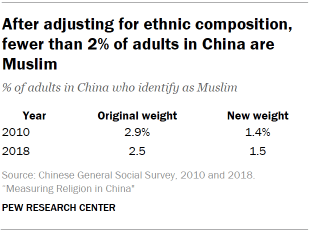
One approach to estimating the number of Muslims in China is to simply add up the members of each traditionally Muslim ethnic group using census data. However, this approach assumes that all members of these specific ethnic groups identify as Muslim, though survey data indicates that this is not the case. Roughly 10% of Hui or Uyghur adults do not identify as Muslims, according to the 2010 Chinese General Social Survey (CGSS). Second, this approach fails to consider Muslim converts of other ethnicities, especially among the majority Han population.
Many surveys exclude Xinjiang, a sparsely populated province where most Chinese Muslims reside.106 Furthermore, most surveys are not weighted to represent China’s ethnic composition. To address these issues, we modified the weight in the CGSS – the survey with the most extensive geographic coverage – to match the ethnic composition of China.107 We adjusted the shares of Huis and Uyghurs (who account for more than 90% of China’s predominantly Muslim ethnic population) and Zhuang adults (China’s largest ethnic minority group) to align with their shares in the Chinese census.

In addition, because the CGSS has not been conducted in Xinjiang since 2013 and Xinjiang is home to not only most Uyghurs (99%), but according to the 2020 census, is also home to five other predominantly Muslim ethnic minorities – Kazakh (99%), Tajik (99%), Kirgiz (97%), Uzbek (97%) and Tatar (92%) – we made adjustments so that in aggregate, these five ethnic groups are proportionally represented in the CGSS sample.
We used ethnic composition information from the 2010 Chinese census to reweight the CGSS waves conducted between 2010 and 2015, and the latest 2020 census was used to adjust the weight in the 2017, 2018 and 2021 CGSS.
After the weight adjustment, the ethnic composition in the CGSS is comparable with the census. For instance, in the 2018 CGSS, Uyghur and Hui adults, together with five smaller predominantly Muslim ethnic groups, account for roughly 1.6% of the adult population, which is identical to their share in the 2020 census.
This approach assumes the Muslim share among Hui people continues to be a good estimate of the Muslim share among Uyghurs and other Muslim-ethnic groups mostly living in Xinjiang.108 The 2010 CGSS found about nine-in-ten Hui adults (89%) and Uyghurs (90%) identified as Muslim. Muslims identification was higher among both groups in the 2012 CGSS (96% Hui, 99% Uyghur).
Based on this data, it seems reasonable to assume that Uyghurs and Huis identify as Muslim at similar rates, though more data is needed to gauge how Muslim identification among Huis and Uyghurs may have changed in recent years. After 2013, the CGSS did not collect data in Xinjiang. In any case, adjusting the ethnic composition improves the proportional representation of Muslims in the CGSS by properly representing the aggregate size of traditionally Muslim ethnic groups.
Exploring the underreporting of zongjiao affiliation in Chinese surveys
Scholars often argue that Chinese surveys that ask about religious belief (zongjiao xinyang) may suffer from underreporting. They argue that this issue may specifically lead to an undercount of Christians, because some Christians – particularly those who worship in unauthorized churches – may not agree to be interviewed or divulge their religious identity to interviewers.109
In recent years, the Chinese government has tightened control over religion and intensified crackdowns on unauthorized religious groups and activities. It is possible that surveys now suffer from more underreporting than in the past, as Chinese people are under more pressure to distance themselves from religion (zongjiao), especially unauthorized zongjiao activities.
However, there has been limited research examining the underreporting of religious affiliation in China using survey data, and we do not know whether the underreporting of zongjiao affiliation has become more common in recent years.
How zongjiao estimates compare between surveys with different wording
Chinese surveys that ask about religious affiliation using zongjiao as the key concept are comparable, but the question wordings and sequencing of response options are not identical. For example, the CGSS zongjiao question is worded as “What is your religious belief (zongjiao xinyang)?” and the survey consistently lists “No zongjiao xinyang” as the first response option. Meanwhile, the corresponding 2016 CFPS question is “To which zongjiao do you belong (shuyu)?” with “No zongjiao xinyang” offered as the second to last response option. (Read Appendix B for details on other survey questions).
These issues may affect zongjiao estimates and contribute to differences between survey results. For example, some studies have noted the “primacy effect” – i.e., that the first category in a list tends to be over-selected by respondents. In other words, surveys with “No zongjiao xinyang” listed as the first option are likely to produce a higher share of religiously unaffiliated people than surveys that place this option last.
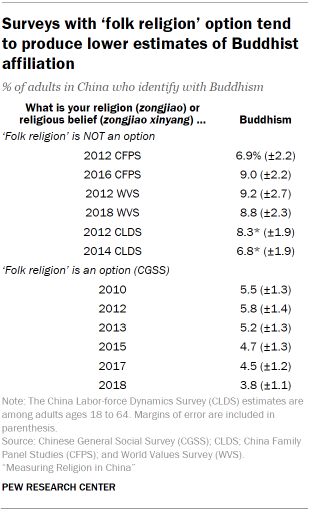
To explore these differences, we look closer at a variety of Christian and Buddhist estimates, by 1) comparing surveys with identical wording but different response orders, using the 2012 and 2018 WVS and 2) by comparing surveys with different wording but the same response orders.
(The CGSS estimate for Buddhist affiliation is omitted from the analysis because unlike other surveys, the CGSS survey includes a “Folk religion” category in the response option. And our analysis shows that surveys with the “Folk religion” option generally produce a lower estimate of adults who identify with Buddhism than surveys without a “Folk religion” response option.)
Our analysis indicates that zongjiao measures generally produce similar results across surveys despite differences in question wording and response orders (at least, when it comes to the placement of the “No zongjiao” option.) The differences in Christian or Buddhist estimates between surveys are not statistically different.

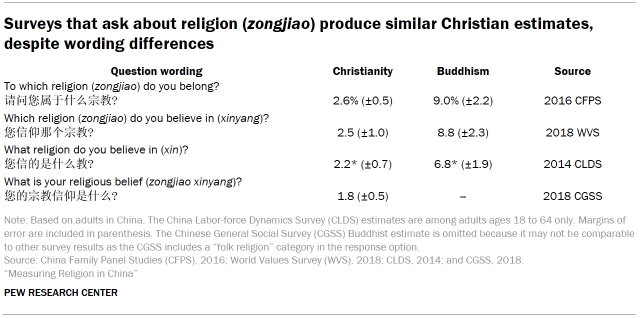
Identifying with more than one religion
In addition, surveys that allow respondents to choose more than one response option to the zongjiao question produce statistically insignificant differences compared with those that allow only one answer. This is because most Chinese people who identify with a religion identify with only one, even though many mix beliefs and practices from multiple faiths. Fewer than 0.5% of adults chose more than one religion across all four waves of the CGSS (2012-17), which allow respondents to choose more than one answer to the question “What is your religious belief (zongjiao xinyang)?”110

The most common combination of faiths is Buddhism and folk religions (74 out of the total 46,747 respondents), followed by Buddhism and Taoism (19), and Taoism and folk religions (15), according to pooled data from four waves of the CGSS. Mixing traditional Chinese religions with non-traditional religions is rare. Fewer than 20 respondents identified with both (a) traditional Chinese religion(s) such as Buddhism, Taoism or folk religions, and (a) nontraditional religion(s) such as Catholicism, Orthodox Christianity, Protestantism or Islam at the same time.

Identifying with more than two religions is also uncommon: Only 11 respondents across four waves chose more than two religions.
When estimating religious composition in China, we collapsed respondents with more than one religion into a single religion to avoid double-counting. We categorized respondents based on considerations of scarcity and stigmatization. When respondents identified with more than one religion, we classified them based on the identity that is more stigmatized in Chinese society and/or the less common religion.
For example, between Buddhism and Taoism, Taoism is rarer, and between Christianity and Taoism, Christianity is more stigmatized in China.
There are other plausible approaches to handling cases with multiple faiths, such as assigning anyone who identifies with more than one religion to the “Other religions” category. But because adults with multiple faiths make up only a tiny fraction of the population, any recoding strategy has little impact on the share of each religious group. Alternative recoding approaches produce similar results as those presented in this report. In the 2017 CGSS for example, Buddhists account for 4.5% of the total adult population, according to the above approach. The estimate remains the same when excluding respondents who identified with Buddhism and (an)other religion(s) at the same time. A similar pattern exists for Christianity, Islam and folk religions.
Our previous estimates of China’s religious composition
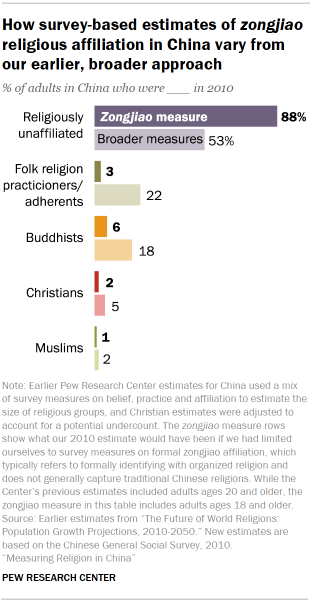
In this report, we describe the challenges of estimating the sizes of religious groups in China and explain how estimates vary depending on whether the underlying survey data measures formal zongjiao affiliation, or (non-zongjiao) beliefs and practices. We also describe cultural and political pressures that could constrain what respondents say in surveys.
This report is Pew Research Center’s most in-depth analysis of the challenges of measuring religion in China, but it is not the first time we have wrestled with this topic. For example, our 2011 report on Global Christianity included a lengthy Appendix about the difficulty of measuring Christianity in China. In the Methodology for our 2012 report, “The Global Religious Landscape,” we explained how we used a unique mix of methods to address challenges of estimating the size of China’s religious groups.
The 2011 and 2012 reports relied on the 2007 Spiritual Life Study of Chinese Residents (SLSCR), which included many religion questions.111 The SLSCR has not been repeated and many of its survey questions have not been asked by other survey organizations. Nonetheless, even when we wrote our earlier reports, it was clear that according to zongjiaomeasures of formal affiliation, nearly nine-in-ten Chinese could be classified as religiously unaffiliated.
In 2011 and 2012, we took non-zongjiao measures into account when making estimates, which means our estimates were larger than zongjiaomeasures alone would indicate. For example, our estimate of the size of the Buddhist population was informed by a measure of believing in (xin) Buddha, a more inclusive measure than zongjiao identity.
The 2007 SLSCR survey did not offer a zongjiao measure of folk religions, so we classified people in the folk religion category by considering their beliefs and practices.112 We also adjusted our estimate of the Christian population in light of evidence of underreporting among Chinese Christians.113
Can Chinese survey data be trusted?
The Chinese government monitors and restricts many aspects of life, including which websites are available to Chinese residents, as well as what kinds of content can be discussed on popular messaging and blogging sites, such as WeChat and Weibo. Authorities also regulate academic research and social surveys in China.
As a result, readers may wonder how much trust to place in surveys conducted by Chinese academic organizations, such as the Chinese General Social Survey (CGSS), the China Family Panel Studies (CFPS) and the China Labor-force Dynamics Survey (CLDS).
On the one hand, these surveys are conducted by researchers at state-supervised, publicly funded universities, and the surveys themselves are often indirectly financed by the Chinese government.114 Scholars at Chinese universities may need the government’s tacit or explicit approval to continue their research and advance in their careers. Also, when survey interviewers introduce themselves to respondents, they may present letters of recommendation from local authorities to help demonstrate their legitimacy. Interviewers sometimes seek additional help from local officials to gain cooperation from interviewees, and in some cases an official may even be present during the interview, although this appears to be rare. For example, a local official was recorded as being present during 0.4% of interviews for the 2018 CFPS.115
On the other hand, the scholars at Renmin University, Peking University and Sun Yat-sen University who conduct the CGSS, CFPS and CLDS are highly credentialed experts in their fields. Each of these survey teams has an international advisory committee that includes experts in survey methodology. For example, the CFPS team collaborated with researchers from the University of Michigan’s Survey Research Center to design and carry out their survey project. Finally, the consistency of survey results over many years, and the comparability of results across survey projects, suggests that the findings do not fluctuate substantially in response to changing government regulations of religion. And, in addition to the government-supported academic surveys analyzed in this report, data collected by Horizon Research Consultancy Group, a private organization that conducts surveys in China, shows broadly similar patterns in measures of religion.
This report discusses both the strengths and the limitations of information on religion from China. Pew Research Center’s demographers have identified and clearly called out some data points that should be viewed with caution, such as official statistics on numbers of worship sites.
Overall, however, the survey findings discussed in this report can be considered the best available source of national-level information in a country where Pew Research Center and other independent, international researchers are not currently able to freely conduct their own surveys. While it is possible that Chinese respondents do not reveal the full extent of their religious affiliations, beliefs and practices to interviewers, multiple surveys conducted by different organizations over the past two decades consistently show Chinese respondents telling interviewers they have low levels of identification with organized religion (zongjiao), yet they affirm specific beliefs and practices that may be considered spiritual or religious.
Aside from surveys, there are limited methods for measuring China’s religious landscape. Qualitative studies of communities provide rich, nuanced information about religious life in those settings. However, it is impossible to know the extent to which studies in one geographic area of China are representative of other areas. The government collects some statistics through official government religious associations, but the methodology and reliability of these statistics is not clear. Some religious groups collect their own statistics, but no organization collects membership statistics on Buddhists, Taoists or people who observe folk religions. In other words, while it is important to keep in mind the limitations of surveys, they are the best tool available – and in some respects the only tool – for measuring national trends in religion in China.
The COVID-19 pandemic created additional hurdles for survey research. For example, as discussed earlier, the 2021 Chinese General Social Survey was conducted in only 19 of mainland China’s 31 provinces, autonomous regions and municipalities. China enforced strict “zero-COVID” lockdowns during the pandemic, and when the survey was fielded from roughly June to September 2021, the delta variant of the coronavirus made face-to-face surveys difficult in regions where it would otherwise have been conducted.



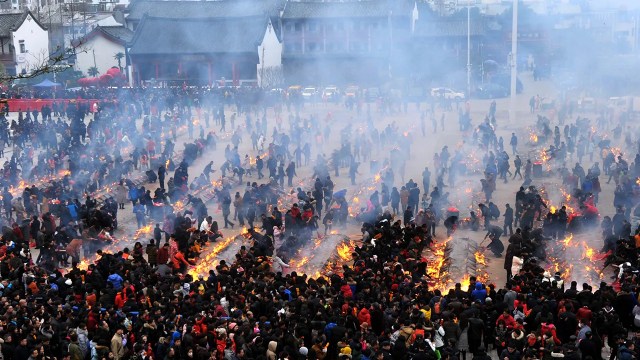
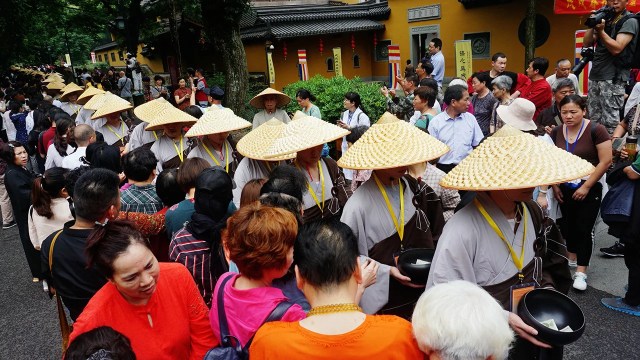

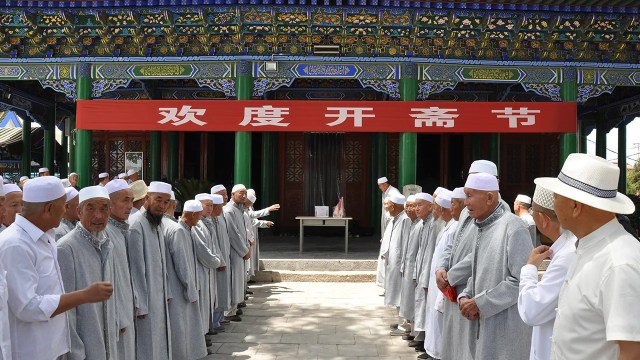
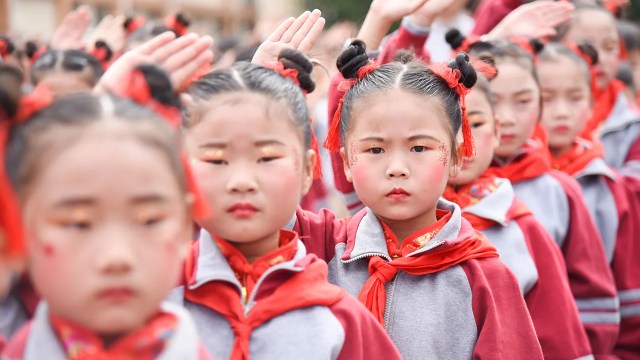
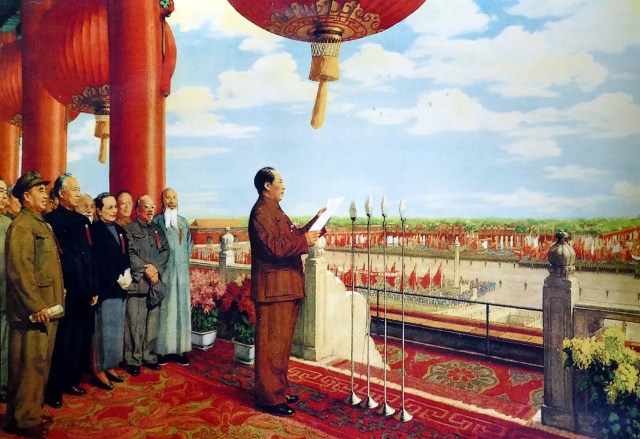
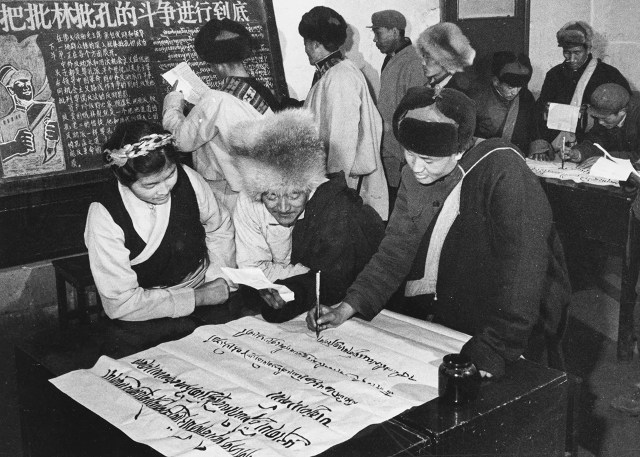


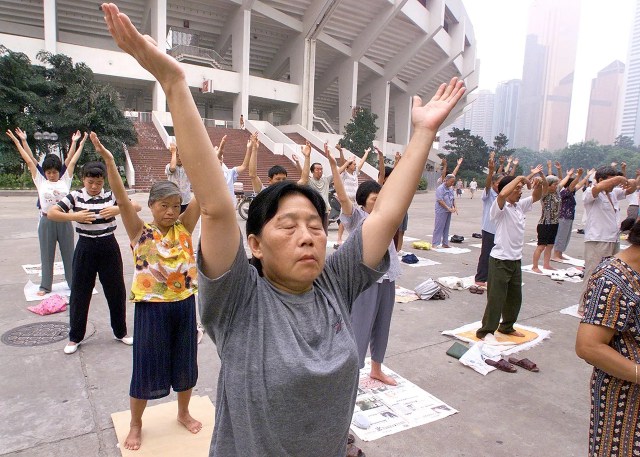
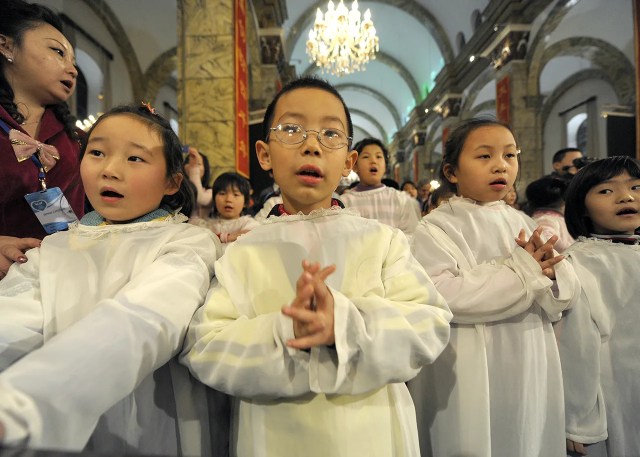
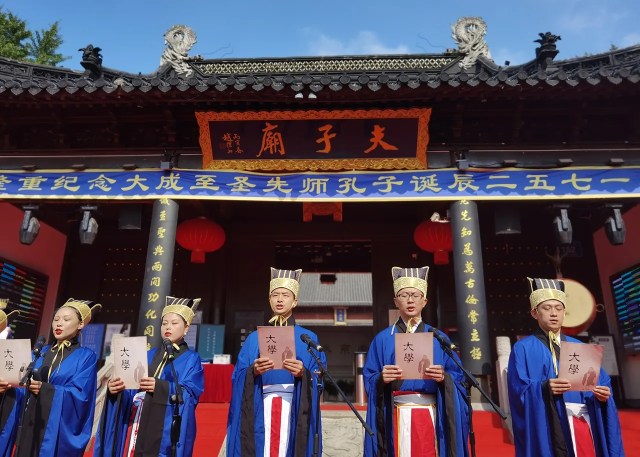






Leave A Comment
You must be logged in to post a comment.